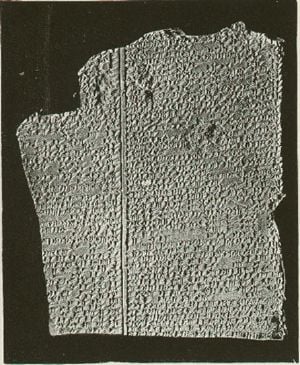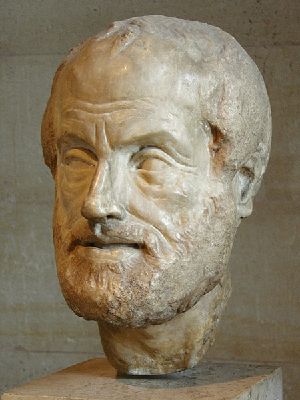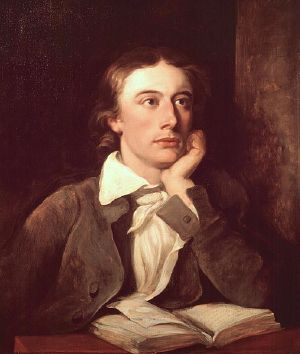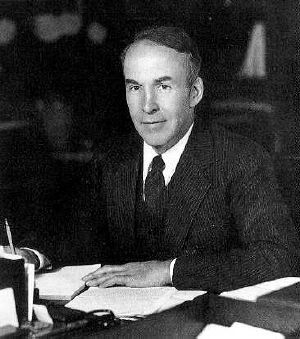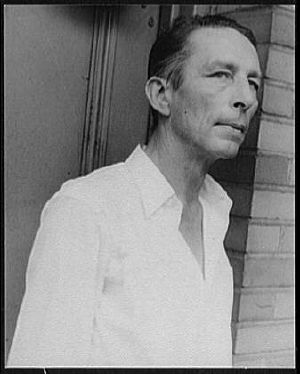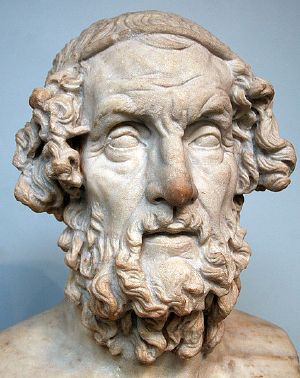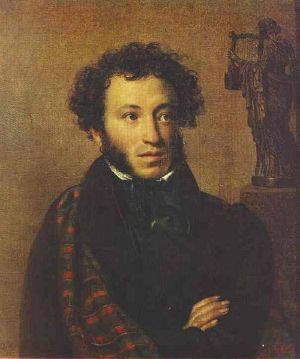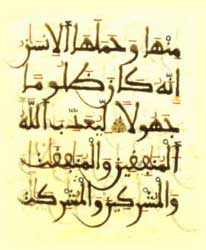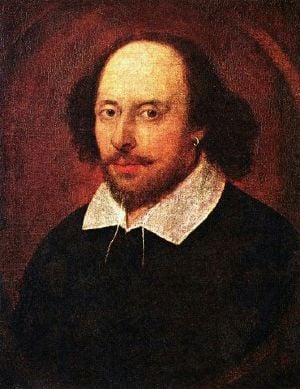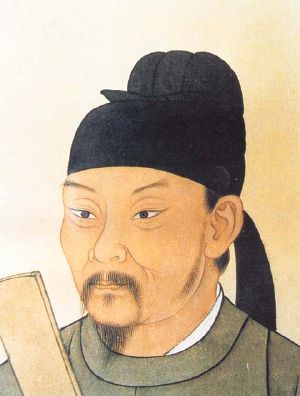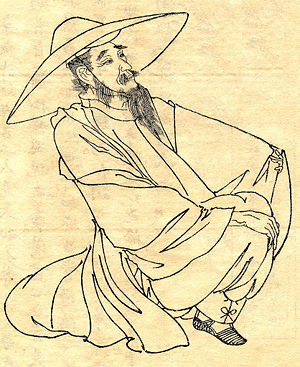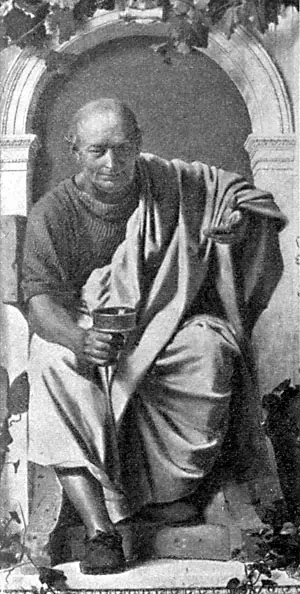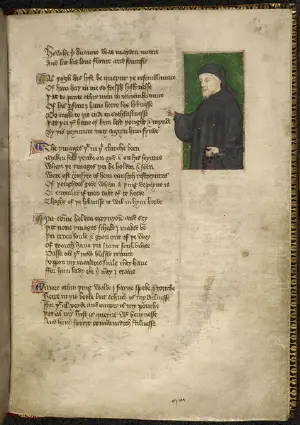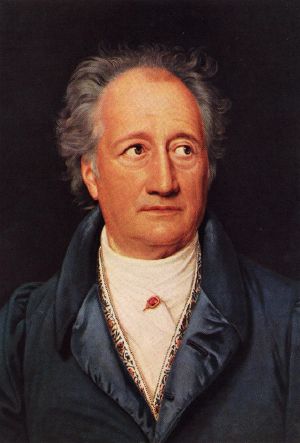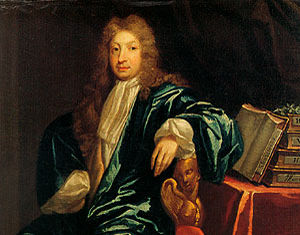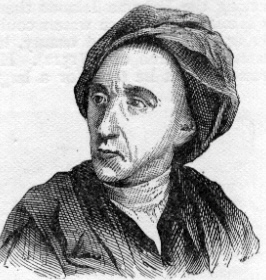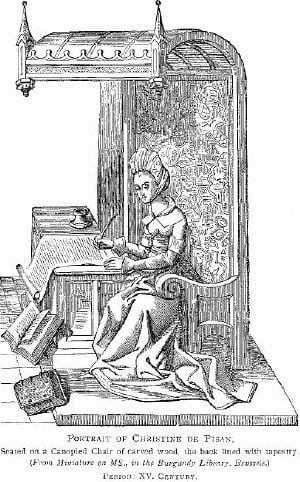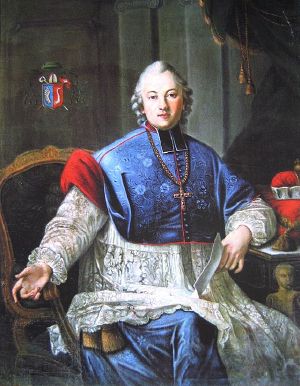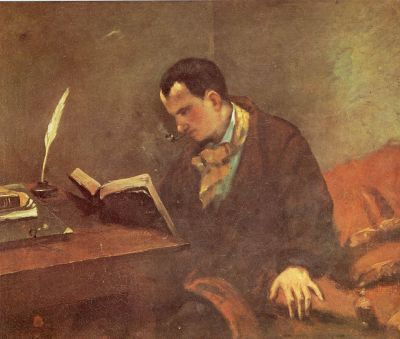Difference between revisions of "Poetry" - New World Encyclopedia
| (77 intermediate revisions by the same user not shown) | |||
| Line 1: | Line 1: | ||
{{submitted}}{{approved}}{{Paid}}{{Copyedited}} | {{submitted}}{{approved}}{{Paid}}{{Copyedited}} | ||
| − | + | {{Literature}} | |
| − | |||
| − | Poetry, and discussions of it, have a long [[history of poetry|history]]. Early attempts to define poetry, such as [[Aristotle]]'s ''[[Poetics (Aristotle)|Poetics]],'' focused on the uses of [[Speech communication|speech]] in [[rhetoric]], [[drama]], [[song]] and [[comedy]].<ref>Malcolm Heath | + | '''Poetry''' (from the [[Greek language|Greek]] "{{Polytonic|ποίησις}}," ''poiesis,'' a "making" or "creating") is a form of [[art]] in which [[language]] is used for its [[aesthetics|aesthetic]] and evocative qualities in addition to, or in lieu of, its ostensible [[meaning (linguistics)|meaning]]. Poetry may be written independently, as discrete poems, or may occur in conjunction with other arts, as in [[poetic drama]], [[hymn]]s, or [[lyrics]]. |
| + | |||
| + | Poetry, and discussions of it, have a long [[history of poetry|history]]. Early attempts to define poetry, such as [[Aristotle]]'s ''[[Poetics (Aristotle)|Poetics]],'' focused on the uses of [[Speech communication|speech]] in [[rhetoric]], [[drama]], [[song]] and [[comedy]].<ref name=Heath>Malcolm Heath (ed), ''Aristotle's Poetics'' (London: Penguin Books, 1997, ISBN 0140446362). </ref> Later attempts concentrated on features such as repetition and [[rhyme]], and emphasized the aesthetics which distinguish poetry from [[prose]].<ref name=Kant>Immanuel Kant, J.H. Bernhard (trans.), ''Critique of Judgment'' (Wentworth Press, 2016, ISBN 978-1371253288).</ref> From the mid-twentieth century, poetry has sometimes been more loosely defined as a fundamental creative act using [[language]].<ref name=QuiteEarly>Dylan Thomas, ''Quite Early One Morning'' (New York: New Direction Books, 1968, ISBN 0811202089). </ref> | ||
| − | Poetry often uses particular forms and conventions to expand the literal meaning of the words, or to evoke emotional or sensual responses. Devices such as [[assonance]], [[alliteration]], [[onomatopoeia]] and [[rhythm]] are sometimes used to achieve [[music]]al or [[incantation|incantatory]] effects. Poetry's use of [[ambiguity]], [[symbolism]], [[irony]] and other [[stylistics (linguistics)|stylistic]] elements of [[poetic diction]] often leaves a poem open to multiple interpretations. Similarly, [[metaphor]] and [[simile]] create a resonance between otherwise disparate images–a layering of [[meaning (linguistics)|meaning]]s, forming connections previously not perceived. Kindred forms of resonance may exist, between individual [[Verse (poetry)|verse]]s, in their patterns of [[rhyme]] or rhythm. | + | Poetry often uses particular forms and conventions to expand the literal meaning of the words, or to evoke emotional or sensual responses. Devices such as [[assonance]], [[alliteration]], [[onomatopoeia]], and [[rhythm]] are sometimes used to achieve [[music]]al or [[incantation|incantatory]] effects. Poetry's use of [[ambiguity]], [[symbolism]], [[irony]], and other [[stylistics (linguistics)|stylistic]] elements of [[poetic diction]] often leaves a poem open to multiple interpretations. Similarly, [[metaphor]] and [[simile]] create a resonance between otherwise disparate images–a layering of [[meaning (linguistics)|meaning]]s, forming connections previously not perceived. Kindred forms of resonance may exist, between individual [[Verse (poetry)|verse]]s, in their patterns of [[rhyme]] or rhythm. |
{{toc}} | {{toc}} | ||
| − | Some forms of poetry are specific to particular [[culture]]s and [[genre]]s, responding to the characteristics of the language in which the poet writes. While readers accustomed to identifying poetry with [[Dante Alighieri|Dante]], [[Johann Wolfgang von Goethe|Goethe]], [[Adam Mickiewicz|Mickiewicz]] and [[Rumi]] may think of it as being written in [[rhyme|rhyming]] lines and regular [[meter (poetry)|meter]], there are traditions, such as those of [[Du Fu]] and ''[[Beowulf]],'' that use other approaches to achieve rhythm and [[euphony]]. In today's [[globalization|globalized]] world, poets often borrow styles, techniques and forms from diverse cultures and languages. | + | [[Image:Quatrain on Heavenly Mountain.jpg|thumb|right|350px|The [[Chinese poetry|Chinese poem]] "Quatrain on Heavenly Mountain" by [[Emperor Gaozong of Song|Emperor Gaozong]] ([[Song Dynasty]])]] |
| + | Some forms of poetry are specific to particular [[culture]]s and [[genre]]s, responding to the characteristics of the language in which the poet writes. While readers accustomed to identifying poetry with [[Dante Alighieri|Dante]], [[Johann Wolfgang von Goethe|Goethe]], [[Adam Mickiewicz|Mickiewicz]], and [[Rumi]] may think of it as being written in [[rhyme|rhyming]] lines and regular [[meter (poetry)|meter]], there are traditions, such as those of [[Du Fu]] and ''[[Beowulf]],'' that use other approaches to achieve rhythm and [[euphony]]. In today's [[globalization|globalized]] world, poets often borrow styles, techniques, and forms from diverse cultures and languages. | ||
==History== | ==History== | ||
{{Main|History of poetry|Literary theory}} | {{Main|History of poetry|Literary theory}} | ||
| − | [[Image:GilgameshTablet.jpg|right|thumb| | + | [[Image:GilgameshTablet.jpg|right|thumb|300px|The [[deluge (mythology)|Deluge]] tablet of the [[Epic of Gilgamesh|Gilgamesh epic]] in [[Akkadian language|Akkadian]], circa second millennium B.C.E..]] |
| + | |||
| + | Poetry as an art form may predate [[literacy]].<ref>Many scholars, particularly those researching the Homeric tradition and the oral epics of the Balkans, suggest that early writing shows clear traces of older oral poetic traditions, including the use of repeated phrases as building blocks in larger poetic units. A rhythmic and repetitious form would make a long story easier to remember and retell, before writing was available as an aide-memoire.</ref> Many ancient works, from the ''[[Vedas]]'' (1700–1200 B.C.E.) to the ''[[Odyssey]]'' (eighth century B.C.E.–675 B.C.E.), appear to have been composed in poetic form to aid memorization and oral transmission, in prehistoric and ancient societies.<ref>Frederick Ahl and Hannah M. Roisman, ''The Odyssey Re-Formed'' (Ithaca, NY: Cornell University Press, 1996, ISBN 0801483352), 1–26.</ref> Others suggest that poetry did not necessarily predate writing.<ref> Jack Goody, ''The Interface Between the Written and the Oral'' (Cambridge, UK: Cambridge University Press, 1987, ISBN 0521337941), 98.</ref> Poetry appears among the earliest records of most literate cultures, with poetic fragments found on early [[monolith]]s, [[rune stone]]s and [[stele|stelae]]. | ||
| − | + | The oldest surviving poem is the ''[[Epic of Gilgamesh]],'' from the third millennium B.C.E. in [[Sumer]] (in [[Mesopotamia]], now [[Iraq]]), which was written in [[cuneiform script]] on clay tablets and, later, [[papyrus]].<ref>N.K. Sanders, (trans.), ''The Epic of Gilgamesh'' (Penguin Classics, 1960, ISBN 978-0140441000).</ref> Other ancient [[epic poetry]] includes the [[Greek language|Greek]] epics, ''[[Iliad]]'' and ''[[Odyssey]],'' and the [[Indian epic poetry|Indian epics]], ''[[Ramayana]]'' and ''[[Mahabharata]].'' | |
| − | The | + | The efforts of ancient thinkers to determine what makes poetry distinctive as a form, and what distinguishes good poetry from bad, resulted in "[[poetics]]"–the study of the [[aesthetics]] of poetry. Some ancient societies, such as the Chinese through the ''[[Shi Jing]],'' one of the [[Five Classics]] of [[Confucianism]], developed canons of poetic works that had [[ritual]] as well as aesthetic importance. More recently, thinkers have struggled to find a definition that could encompass formal differences as great as those between [[Chaucer]]'s ''[[The Canterbury Tales|Canterbury Tales]]'' and [[Matsuo Bashō]]'s ''[[Oku no Hosomichi]],'' as well as differences in context spanning [[Tanakh]] [[Biblical poetry|religious poetry]], [[Romantic love|love]] poetry, and [[rapping|rap]]. |
| − | + | [[Image:Valéry01.jpg|thumb|300px|[[Paul Valéry]], drawn by himself.]] | |
| − | [[Image:Valéry01.jpg|thumb| | + | Context can be critical to poetics and to the development of poetic [[genre]]s and [[form]]s. Poetry that records historic events in [[epic poetry|epics]], such as ''[[Epic of Gilgamesh|Gilgamesh]]'' or Ferdowsi's ''[[Shahnameh]]'',<ref>Abolqasem Ferdowsi, Dick Davis (Trans.), ''Shahnameh: The Persian Book of Kings'' (New York: Viking, 2006, ISBN 0670034851).</ref> will necessarily be lengthy and [[narrative poetry|narrative]], while poetry used for [[liturgy|liturgical]] purposes ([[hymn]]s, [[psalm]]s, [[sura]]s and [[hadith]]s) is likely to have an inspirational tone, whereas [[elegy]] and [[tragedy]] are meant to evoke deep [[emotional responses]]. Other contexts include [[Gregorian chant]]s, formal or diplomatic speech, for example, in the Arabic world, much [[diplomacy]] was carried out through poetic form in the sixteeenth century. <ref>Natalie Zemon Davis, ''Trickster's Travels'' (Hill & Wang, 2006, ISBN 0809094355).</ref> [[politics|political]] [[rhetoric]] and [[invective]],<ref> Examples of political invective include [[libel (poetry)|libel poetry]] and the classical [[epigrams]] of [[Martial]] and [[Catullus]].</ref> light-hearted [[nursery rhyme|nursery]] and [[nonsense verse|nonsense rhymes]], and even [[medical]] texts.<ref>In [[ancient Greece]], medical and scholarly works were often written in metrical form. A millennium and a half later, many of [[Avicenna]]'s medical texts were written in verse.</ref> |
| − | Context can be critical to poetics and to the development of poetic [[genre]]s and [[form]]s. Poetry that records historic events in [[epic poetry|epics]], such as ''[[Epic of Gilgamesh|Gilgamesh]]'' or Ferdowsi's ''[[Shahnameh]]'',<ref>Abolqasem Ferdowsi, Dick Davis | ||
| − | The Polish historian of aesthetics, [[Władysław Tatarkiewicz]], in a paper on "The Concept of Poetry," traces the evolution of what is in fact ''two [[concept]]s of poetry.'' Tatarkiewicz points out that the term is applied to two distinct things that, as the poet [[Paul Valéry]] observes, "at a certain point find union. Poetry […] is an art based on ''language.'' But poetry also has a more general meaning […] that is difficult to define because it is less determinate: poetry expresses a certain '' | + | The Polish historian of aesthetics, [[Władysław Tatarkiewicz]], in a paper on "The Concept of Poetry," traces the evolution of what is in fact ''two [[concept]]s of poetry.'' Tatarkiewicz points out that the term is applied to two distinct things that, as the poet [[Paul Valéry]] observes, "at a certain point find union. Poetry […] is an art based on ''language.'' But poetry also has a more general meaning […] that is difficult to define because it is less determinate: poetry expresses a certain ''state of mind''."<ref name="Concept13">Władysław Tatarkiewicz, "The Concept of Poetry," ''Dialectics and Humanism'' II(2) (Spring 1975): 13.</ref> |
===Western traditions=== | ===Western traditions=== | ||
| − | [[Image:Aristoteles Louvre.jpg|thumb| | + | [[Image:Aristoteles Louvre.jpg|thumb|300px|[[Aristotle]].]] |
| − | Classical thinkers employed classification as a way to define and assess the quality of poetry. Notably, the existing fragments of [[Aristotle]]'s ''[[Poetics (Aristotle)|Poetics]]'' describe [[Poetics#The three genres of poetry|three genres of poetry]]—the epic, the comic, and the tragic—and develop rules to distinguish the highest-quality poetry in each genre, based on the underlying purposes of the genre.<ref | + | Classical thinkers employed classification as a way to define and assess the quality of poetry. Notably, the existing fragments of [[Aristotle]]'s ''[[Poetics (Aristotle)|Poetics]]'' describe [[Poetics#The three genres of poetry|three genres of poetry]]—the epic, the comic, and the tragic—and develop rules to distinguish the highest-quality poetry in each genre, based on the underlying purposes of the genre.<ref name=Heath/> Later [[aesthetician]]s identified three major genres: [[epic poetry]], [[lyric poetry]] and [[dramatic poetry]], treating [[comedy]] and [[tragedy]] as [[subgenre]]s of dramatic poetry. |
| − | Aristotle's work was influential throughout the Middle East during the [[Islamic Golden Age]],<ref>[[Averroes|Ibn Rushd]] wrote a commentary on the Aristotle's ''Poetics'', replacing the original examples with passages from Arabic poets. | + | Aristotle's work was influential throughout the Middle East during the [[Islamic Golden Age]],<ref>[[Averroes|Ibn Rushd]] wrote a commentary on the Aristotle's ''Poetics'', replacing the original examples with passages from Arabic poets. See, for example, W. F. Bogges, 'Hermannus Alemannus' Latin Anthology of Arabic Poetry,' ''Journal of the American Oriental Society'' 88 (1968): 657–670, and Charles Burnett, "Learned Knowledge of Arabic Poetry, Rhymed Prose, and Didactic Verse from Petrus Alfonsi to Petrarch," in ''Poetry and Philosophy in the Middle Ages: A Festschrift for Peter Dronke'' (Brill Academic Publishers, 2001, ISBN 9004119647).</ref> as well as in Europe during the [[Renaissance]].<ref>Paul F. Grendler, ''The Universities of the Italian Renaissance'' (Baltimore, MD: Johns Hopkins University Press, 2004, ISBN 0801880556).</ref> Later poets and aestheticians often distinguished poetry from, and defined it in opposition to, [[prose]], which was generally understood as writing with a proclivity to logical explication and a linear narrative structure. [[Kant]], for example, argues that the nature of poetry as a self-consciously abstract and beautiful form raises it to the highest level among the verbal arts, with tone or music following it, and only after that the more logical and narrative prose.<ref name=Kant/> |
| − | [[ | + | [[File:John Keats by William Hilton.jpg|thumb|300px|right|Posthumous portrait of Keats by William Hilton]] |
| − | This does not imply that poetry is illogical or lacks narration, but rather that poetry is an attempt to render the beautiful or sublime without the burden of engaging the logical or narrative thought process. English [[Romantic poetry|Romantic]] poet [[John Keats]] termed this escape from logic, "[[Negative Capability]]."<ref>Christensen, | + | This does not imply that poetry is illogical or lacks narration, but rather that poetry is an attempt to render the beautiful or sublime without the burden of engaging the logical or narrative thought process. English [[Romantic poetry|Romantic]] poet [[John Keats]] termed this escape from logic, "[[Negative Capability]]."<ref>A. Christensen, L. Crisafulli-Jones, G. Galigani, and A. Johnson (eds.), ''The Challenge of Keats'' (Amsterdam, The Netherlands: Rodopi, 2000, ISBN 978-9042004993).</ref> This "romantic" approach views [[form]] as a key element of successful poetry because form is abstract and distinct from the underlying notional logic. This approach remained influential into the twentieth century. |
During this period, there was also substantially more interaction among the various poetic traditions, in part due to the spread of European [[colonialism]] and the attendant rise in global trade. In addition to a boom in [[translation]], during the Romantic period numerous ancient works were rediscovered. | During this period, there was also substantially more interaction among the various poetic traditions, in part due to the spread of European [[colonialism]] and the attendant rise in global trade. In addition to a boom in [[translation]], during the Romantic period numerous ancient works were rediscovered. | ||
===Twentieth-century disputes=== | ===Twentieth-century disputes=== | ||
| − | [[Image:Archibaldmacleish.jpeg|thumb| | + | [[Image:Archibaldmacleish.jpeg|thumb|300px|[[Archibald MacLeish]]]] |
| − | Some twentieth century [[Literary theory|literary theorist]]s, relying less on the opposition of prose and poetry, focused on the poet as simply one who creates using language, and poetry as what the poet creates. The underlying concept of the poet as creator is not uncommon, and some [[modernist poetry|modernist poets]] essentially do not distinguish between the creation of a poem with words, and creative acts in other media such as carpentry.<ref | + | Some twentieth century [[Literary theory|literary theorist]]s, relying less on the opposition of prose and poetry, focused on the poet as simply one who creates using language, and poetry as what the poet creates. The underlying concept of the poet as creator is not uncommon, and some [[modernist poetry|modernist poets]] essentially do not distinguish between the creation of a poem with words, and creative acts in other media such as carpentry.<ref name=QuiteEarly/> Yet other modernists challenge the very attempt to define poetry as misguided, as when [[Archibald MacLeish]] concludes his paradoxical poem, "[[Ars Poetica]]," with the lines: "A poem should not mean / but be."<ref>The title of "[[Ars Poetica]]" [[allusion|allude]]s to [[Horace]]'s commentary of the same title. The poem sets out a range of dicta for what poetry ought to be, before concluding with its classic lines. </ref> |
| − | Disputes over the definition of poetry, and over poetry's distinction from other genres of [[literature]], have been inextricably intertwined with the debate over the role of poetic form. The rejection of traditional forms and structures for poetry that began in the first half of the twentieth century, coincided with a questioning of the purpose and meaning of traditional definitions of poetry and of distinctions between poetry and prose, particularly given examples of poetic prose and [[prose poetry|prosaic "poetry"]]. Numerous modernist poets have written in non-traditional forms or in what traditionally would have been considered prose, although their writing was generally infused with poetic diction and often with rhythm and tone established by non-metrical means.<ref> | + | Disputes over the definition of poetry, and over poetry's distinction from other genres of [[literature]], have been inextricably intertwined with the debate over the role of poetic form. The rejection of traditional forms and structures for poetry that began in the first half of the twentieth century, coincided with a questioning of the purpose and meaning of traditional definitions of poetry and of distinctions between poetry and prose, particularly given examples of poetic prose and [[prose poetry|prosaic "poetry"]]. Numerous modernist poets have written in non-traditional forms or in what traditionally would have been considered prose, although their writing was generally infused with poetic diction and often with rhythm and tone established by non-metrical means.<ref>A. Walton Litz and Christopher MacGowan (eds.), ''The Collected Poems of William Carlos Williams'' (New York, NY: New Directions Publications, 1991, ISBN 978-0811211871).</ref> While there was a substantial [[Formalism|formalist]] reaction within the modernist schools to the breakdown of structure, this reaction focused as much on the development of new formal structures and syntheses as on the revival of older forms and structures.<ref> T. S. Eliot, ''The Waste Land and Other Poems'' (Vintage, 2021, ISBN 978-0593313343).</ref> |
| − | More recently, [[postmodernism]] has fully embraced MacLeish's concept and come to regard boundaries between prose and poetry, and also among genres of poetry, as having meaning only as cultural artifacts. Postmodernism goes beyond modernism's emphasis on the creative role of the poet, to emphasize the role of the [[reader]] of a text, and to highlight the complex cultural web within which a poem is read.<ref> | + | More recently, [[postmodernism]] has fully embraced MacLeish's concept and come to regard boundaries between prose and poetry, and also among genres of poetry, as having meaning only as cultural artifacts. Postmodernism goes beyond modernism's emphasis on the creative role of the poet, to emphasize the role of the [[reader]] of a text, and to highlight the complex cultural web within which a poem is read.<ref>Roland Barthes, "Death of the Author" in ''Image Music Text'' (Hill and Wang, 1978, ISBN 0374521360).</ref> Today, throughout the world, poetry often incorporates poetic form and diction from other cultures and from the past, further confounding attempts at definition and classification that were once sensible within a tradition such as the [[Western canon]]. |
==Basic elements== | ==Basic elements== | ||
| Line 46: | Line 49: | ||
{{Main|Meter (poetry)}} | {{Main|Meter (poetry)}} | ||
| − | [[Prosody (linguistics)|Prosody]] is the study of the [[Meter (poetry)|meter]], [[rhythm]], and [[Intonation (linguistics)|intonation]] of a poem. Rhythm and meter, although closely related, should be distinguished.<ref> | + | [[Prosody (linguistics)|Prosody]] is the study of the [[Meter (poetry)|meter]], [[rhythm]], and [[Intonation (linguistics)|intonation]] of a poem. Rhythm and meter, although closely related, should be distinguished.<ref name=Pinsky>Robert Pinsky, ''The Sounds of Poetry'' (New York: Farrar, Straus and Giroux, 1998, ISBN 9780374266950).</ref> Meter is the definitive pattern established for a verse (such as iambic pentameter), while rhythm is the actual sound that results from a line of poetry. Thus, the meter of a line may be described as being "iambic," but a full description of the rhythm would require noting where the language causes one to pause or accelerate and how the meter interacts with other elements of the language. Prosody also may be used more specifically to refer to the [[scansion|scanning]] of poetic lines to show meter. |
====Rhythm==== | ====Rhythm==== | ||
| − | The methods for creating poetic rhythm vary across languages and between poetic traditions. Languages are often described as having [[timing (linguistics)|timing]] set primarily by [[stress-timed language|accents]], [[syllable-timed language|syllables]], or [[mora-timed language|moras]], depending on how rhythm is established, though a language can be influenced by multiple approaches.<ref>Julia Schülter | + | The methods for creating poetic rhythm vary across languages and between poetic traditions. Languages are often described as having [[timing (linguistics)|timing]] set primarily by [[stress-timed language|accents]], [[syllable-timed language|syllables]], or [[mora-timed language|moras]], depending on how rhythm is established, though a language can be influenced by multiple approaches.<ref>Julia Schülter, ''Rhythmic Grammar: The Influence of Rhythm on Grammatical Variation and Change in English'' (Berlin, Germany: Walter de Gruyter, 2005, ISBN 3110186071).</ref> [[Japanese Language|Japanese]] is a mora-timed language. Syllable-timed languages include [[Latin language|Latin]], [[Catalan language|Catalan]], [[French language|French]] and [[Spanish language|Spanish]]. [[English language|English]], [[Russian language|Russian]] and, generally, [[German language|German]] are stress-timed languages. Varying [[Intonation (linguistics)|intonation]] also affects how rhythm is perceived. Languages also can rely on either [[pitch accent|pitch]], such as in Vedic or ancient Greek, or [[tone (linguistics)|tone]]. [[Tonal language]]s include Chinese, Vietnamese, Lithuanian, and most [[Niger-Congo languages|subsaharan languages]].<ref>Moria Yip, ''Tone'' (Cambridge: Cambridge University Press, 2002, ISBN 0521773148). </ref> |
| − | Metrical rhythm generally involves precise arrangements of stresses or syllables into repeated patterns called [[foot (prosody)|feet]] within a line. In Modern English verse the pattern of stresses primarily differentiate feet, so rhythm based on meter in Modern English is most often founded on the pattern of stressed and unstressed syllables (alone or [[elision|elided]]). In the [[classical languages]], on the other hand, while the metrical units are similar, [[vowel length]] rather than stresses define the meter. [[Old English]] poetry used a metrical pattern involving varied numbers of syllables but a fixed number of strong stresses in each line.<ref>Howell D. Chickering | + | Metrical rhythm generally involves precise arrangements of stresses or syllables into repeated patterns called [[foot (prosody)|feet]] within a line. In Modern English verse the pattern of stresses primarily differentiate feet, so rhythm based on meter in Modern English is most often founded on the pattern of stressed and unstressed syllables (alone or [[elision|elided]]). In the [[classical languages]], on the other hand, while the metrical units are similar, [[vowel length]] rather than stresses define the meter. [[Old English]] poetry used a metrical pattern involving varied numbers of syllables but a fixed number of strong stresses in each line.<ref>Howell D. Chickering, ''Beowulf: a Dual-language Edition'' (Garden City, NY: Anchor, 1977, ISBN 0385062133). </ref> |
| − | [[Image:Robinsonjeffers.jpg|thumb|left| | + | [[Image:Robinsonjeffers.jpg|thumb|left|300px|[[Robinson Jeffers]]]] |
| − | The chief device of ancient [[Hebrew language|Hebrew]] [[Biblical poetry]], including many of the [[psalm]]s, was ''[[parallelism (rhetoric)|parallelism]],'' a rhetorical structure in which successive lines reflected each other in grammatical structure, sound structure, notional content, or all three. Parallelism lent itself to [[antiphon]]al or [[call and response (music)|call-and-response]] performance, which could also be reinforced by [[Intonation (linguistics)|intonation]]. Thus, Biblical poetry relies much less on metrical feet to create rhythm, but instead creates rhythm based on much larger sound units of lines, phrases and sentences. Some classical poetry forms, such as [[Venpa]] of the [[Tamil language]], had rigid grammars (to the point that they could be expressed as a [[context-free grammar]]) which ensured a rhythm.<ref>John Lazarus | + | The chief device of ancient [[Hebrew language|Hebrew]] [[Biblical poetry]], including many of the [[psalm]]s, was ''[[parallelism (rhetoric)|parallelism]],'' a rhetorical structure in which successive lines reflected each other in grammatical structure, sound structure, notional content, or all three. Parallelism lent itself to [[antiphon]]al or [[call and response (music)|call-and-response]] performance, which could also be reinforced by [[Intonation (linguistics)|intonation]]. Thus, Biblical poetry relies much less on metrical feet to create rhythm, but instead creates rhythm based on much larger sound units of lines, phrases and sentences. Some classical poetry forms, such as [[Venpa]] of the [[Tamil language]], had rigid grammars (to the point that they could be expressed as a [[context-free grammar]]) which ensured a rhythm.<ref>John Lazarus, W. H. Drew (trans.), ''Thirukkural'' (Asian Educational Services, 2001, ISBN 8120604008). </ref> In [[Chinese poetry]], tones as well as stresses create rhythm. [[Shi (poetry)|Classical Chinese poetics]] identifies [[tone name|four tones]]: the level tone, rising tone, falling tone, and [[entering tone]]. Note that other classifications may have as many as eight tones for Chinese and six for Vietnamese. |
| − | The formal patterns of meter used developed in Modern English verse to create rhythm no longer dominate contemporary English poetry. In the case of [[free verse]], rhythm is often organized based on looser units of cadence than a regular meter. [[Robinson Jeffers]], [[Marianne Moore]], and [[William Carlos Williams]] are three notable poets who reject the idea that regular accentual meter is critical to English poetry.<ref>Marianne Moore | + | The formal patterns of meter used developed in Modern English verse to create rhythm no longer dominate contemporary English poetry. In the case of [[free verse]], rhythm is often organized based on looser units of cadence than a regular meter. [[Robinson Jeffers]], [[Marianne Moore]], and [[William Carlos Williams]] are three notable poets who reject the idea that regular accentual meter is critical to English poetry.<ref>Marianne Moore, ''Idiosyncrasy and Technique'' (Berkeley, CA: University of California, 1958).</ref><ref> William Carlos Williams, ''The Broken Span'' (Norfolk, CT: New Directions, 1941). </ref> [[Robinson Jeffers]] experimented with [[sprung rhythm]] as an alternative to accentual rhythm.<ref>Robinson Jeffers, ''Selected Poems'' (New York, NY: Vintage, 1965, ISBN 978-0394702957).</ref> |
====Meter==== | ====Meter==== | ||
{{Main|Scansion|Systems of scansion}} | {{Main|Scansion|Systems of scansion}} | ||
| − | [[Image:Homer British Museum.jpg|thumb| | + | [[Image:Homer British Museum.jpg|thumb|300px|[[Homer]]]] |
In the Western poetic tradition, [[meter (poetry)|meter]]s are customarily grouped according to a characteristic [[metrical foot]] and the number of feet per line. Thus, "[[iambic pentameter]]" is a meter comprising five feet per line, in which the predominant kind of foot is the "[[iamb]]." This metric system originated in ancient [[Greek poetry]], and was used by poets such as [[Pindar]] and [[Sappho]], and by the great [[Theatre of ancient Greece#The Tragedy|tragedian]]s of [[Athens]]. Similarly, "[[dactylic hexameter]]," comprises six feet per line, of which the dominant kind of foot is the "[[dactyl]]." Dactylic hexameter was the traditional meter of Greek [[epic poetry]], the earliest extant examples of which are the works of [[Homer]] and [[Hesiod]]. | In the Western poetic tradition, [[meter (poetry)|meter]]s are customarily grouped according to a characteristic [[metrical foot]] and the number of feet per line. Thus, "[[iambic pentameter]]" is a meter comprising five feet per line, in which the predominant kind of foot is the "[[iamb]]." This metric system originated in ancient [[Greek poetry]], and was used by poets such as [[Pindar]] and [[Sappho]], and by the great [[Theatre of ancient Greece#The Tragedy|tragedian]]s of [[Athens]]. Similarly, "[[dactylic hexameter]]," comprises six feet per line, of which the dominant kind of foot is the "[[dactyl]]." Dactylic hexameter was the traditional meter of Greek [[epic poetry]], the earliest extant examples of which are the works of [[Homer]] and [[Hesiod]]. | ||
| − | Meter is often scanned based on the arrangement of "[[foot (prosody)|poetic feet]]" into lines.<ref>Paul Fussell | + | Meter is often scanned based on the arrangement of "[[foot (prosody)|poetic feet]]" into lines.<ref>Paul Fussell, ''Poetic Meter and Poetic Form'' (McGraw-Hill, 1979, ISBN 978-0075536062).</ref> In English, each foot usually includes one syllable with a stress and one or two without a stress. In other languages, it may be a combination of the number of syllables and the length of the vowel that determines how the foot is parsed, where one syllable with a long vowel may be treated as the equivalent of two syllables with short vowels. For example, in ancient Greek poetry, meter is based solely on syllable duration rather than stress. In some languages, such as English, stressed syllables are typically pronounced with greater volume, greater length, and higher pitch, and are the basis for poetic meter. In ancient Greek, these attributes were independent of each other; long vowels and syllables including a vowel plus more than one consonant actually had longer duration, approximately double that of a short vowel, while pitch and stress (dictated by the accent) were not associated with duration and played no role in the meter. Thus, a dactylic hexameter line could be envisioned as a musical phrase with six measures, each of which contained either a half note followed by two quarter notes (i.e., a long syllable followed by two short syllables), or two half notes (i.e., two long syllables); thus, the substitution of two short syllables for one long syllable resulted in a measure of the same length. Such substitution in a stress language, such as English, would not result in the same rhythmic regularity. |
| − | In [[Sievers' Theory of Anglo-Saxon Meter|Anglo-Saxon meter]], the unit on which lines are built is a half-line containing two stresses rather than a foot.<ref> | + | In [[Sievers' Theory of Anglo-Saxon Meter|Anglo-Saxon meter]], the unit on which lines are built is a half-line containing two stresses rather than a foot.<ref>Christine Brooke-Rose, ''A ZBC of Ezra Pound'' (Faber and Faber, 1971, ISBN 0571091350).</ref> Scanning meter can often show the basic or fundamental pattern underlying a verse, but does not show the varying degrees of [[stress (linguistics)|stress]], as well as the differing [[pitch accent|pitch]]es and [[vowel length|length]]s of syllables.<ref name=Pinsky/> |
| − | [[Image:Forks and hope.jpg|thumb| | + | [[Image:Forks and hope.jpg|thumb|300px|right|One of [[Henry Holiday]]'s illustrations to [[Lewis Carroll]]'s ''[[The Hunting of the Snark]]'', which is written predominantly in [[anapestic tetrameter]]: "In the midst of the word he was trying to say / In the midst of his laughter and glee / He had softly and suddenly vanished away / For the snark was a boojum, you see."]] |
| − | As an example of how a line of meter is defined, in English-language [[iambic pentameter]], each line has five metrical feet, and each foot is an iamb, or an unstressed syllable followed by a stressed syllable. When a particular line is scanned, there may be variations upon the basic pattern of the meter; for example, the first foot of English iambic pentameters is quite often [[Inversion (prosody)|inverted]], meaning that the stress falls on the first syllable.<ref | + | As an example of how a line of meter is defined, in English-language [[iambic pentameter]], each line has five metrical feet, and each foot is an iamb, or an unstressed syllable followed by a stressed syllable. When a particular line is scanned, there may be variations upon the basic pattern of the meter; for example, the first foot of English iambic pentameters is quite often [[Inversion (prosody)|inverted]], meaning that the stress falls on the first syllable.<ref name=Pinsky/> The generally accepted names for some of the most commonly used kinds of feet include: |
* [[spondee]]—two stressed syllables together | * [[spondee]]—two stressed syllables together | ||
| Line 87: | Line 90: | ||
There are a wide range of names for other types of feet, right up to a [[choriamb]] of four syllable metric foot with a stressed syllable followed by two unstressed syllables and closing with a stressed syllable. The choriamb is derived from some ancient [[Greek poetry|Greek]] and [[Latin poetry]]. Languages which utilize [[vowel length]] or [[Intonation (linguistics)|intonation]] rather than or in addition to syllabic accents in determining meter, such as [[Meter (poetry)#Ottoman Turkish|Ottoman Turkish]] or [[Vedic meter|Vedic]], often have concepts similar to the iamb and dactyl to describe common combinations of long and short sounds. | There are a wide range of names for other types of feet, right up to a [[choriamb]] of four syllable metric foot with a stressed syllable followed by two unstressed syllables and closing with a stressed syllable. The choriamb is derived from some ancient [[Greek poetry|Greek]] and [[Latin poetry]]. Languages which utilize [[vowel length]] or [[Intonation (linguistics)|intonation]] rather than or in addition to syllabic accents in determining meter, such as [[Meter (poetry)#Ottoman Turkish|Ottoman Turkish]] or [[Vedic meter|Vedic]], often have concepts similar to the iamb and dactyl to describe common combinations of long and short sounds. | ||
| − | Each of these types of feet has a certain "feel," whether alone or in combination with other feet. The iamb, for example, is the most natural form of rhythm in the English language, and generally produces a subtle but stable verse.<ref>John Thompson, ''The Founding of English Meter''.</ref> | + | Each of these types of feet has a certain "feel," whether alone or in combination with other feet. The iamb, for example, is the most natural form of rhythm in the English language, and generally produces a subtle but stable verse.<ref>John Thompson, ''The Founding of English Meter'' (Columbia University Press, 1966).</ref> The dactyl, on the other hand, almost gallops along. And, as readers of ''[[A Visit from St. Nicholas|The Night Before Christmas]]'' or [[Dr. Seuss]] realize, the anapest is perfect for a light-hearted, comic feel. For example, lines from "Yertle the Turtle" are scanned in [[anapestic tetrameter]].<ref> Dr. Seuss, ''Yertle the Turtle and Other Stories'' (New York: Random House, 1958, ISBN 978-0394800875). </ref> |
| − | There is debate over how useful a multiplicity of different "feet" is in describing meter. For example, [[Robert Pinsky]] has argued that while dactyls are important in classical verse, English dactylic verse uses dactyls very irregularly and can be better described based on patterns of iambs and anapests, feet which he considers natural to the language.<ref | + | There is debate over how useful a multiplicity of different "feet" is in describing meter. For example, [[Robert Pinsky]] has argued that while dactyls are important in classical verse, English dactylic verse uses dactyls very irregularly and can be better described based on patterns of iambs and anapests, feet which he considers natural to the language.<ref name=Pinsky/> Actual rhythm is significantly more complex than the basic scanned meter described above, and many scholars have sought to develop systems that would scan such complexity. [[Vladimir Nabokov]] noted that overlaid on top of the regular pattern of stressed and unstressed syllables in a line of verse was a separate pattern of accents resulting from the natural pitch of the spoken words, and suggested that the term "scud" be used to distinguish an unaccented stress from an accented stress.<ref name=Nabokov>Vladimir Nabokov, ''Notes on Prosody'' (New York: The Bollingen Foundation, 1964, ISBN 0691017603).</ref> |
====Metrical patterns==== | ====Metrical patterns==== | ||
{{Main|Meter (poetry)}} | {{Main|Meter (poetry)}} | ||
| − | Different traditions and genres of poetry tend to use different meters, ranging from the | + | Different traditions and genres of poetry tend to use different meters, ranging from the [[Shakespeare]]an [[iambic pentameter]] and the Homerian [[dactylic hexameter]] to the [[Anapestic tetrameter]] used in many nursery rhymes. However, a number of variations to the established meter are common, both to provide emphasis or attention to a given foot or line and to avoid boring repetition. For example, the stress in a foot may be inverted, a [[caesura]] (or pause) may be added (sometimes in place of a foot or stress), or the final foot in a line may be given a [[feminine ending]] to soften it or be replaced by a [[spondee]] to emphasize it and create a hard stop. Some patterns (such as iambic pentameter) tend to be fairly regular, while other patterns, such as dactylic hexameter, tend to be highly irregular. Regularity can vary between language. In addition, different patterns often develop distinctively in different languages, so that, for example, [[iambic tetrameter]] in Russian will generally reflect a regularity in the use of accents to reinforce the meter, which does not occur or occurs to a much lesser extent in English.<ref name=Nabokov/> |
| − | [[Image:Kiprensky Pushkin.jpg|thumb| | + | [[Image:Kiprensky Pushkin.jpg|thumb|300px|[[Alexander Pushkin]]]] |
Some common metrical patterns, with notable examples of poets and poems who use them, include: | Some common metrical patterns, with notable examples of poets and poems who use them, include: | ||
| − | * Iambic pentameter ([[John Milton]], ''[[Paradise Lost]]'' | + | * Iambic pentameter ([[John Milton]], ''[[Paradise Lost]]'' |
| − | * Dactylic hexameter (Homer, ''[[Iliad]];'' | + | * Dactylic hexameter (Homer, ''[[Iliad]];'' [[Ovid]], ''[[Metamorphoses (poem)|The Metamorphoses]]'') |
* [[Iambic tetrameter]] ([[Andrew Marvell]], "[[To His Coy Mistress]]") | * [[Iambic tetrameter]] ([[Andrew Marvell]], "[[To His Coy Mistress]]") | ||
| − | * [[Iambic tetrameter]] ([[Aleksandr Pushkin]], ''[[Eugene Onegin]]'') | + | * [[Iambic tetrameter]] ([[Aleksandr Pushkin]], ''[[Eugene Onegin]]'') |
| − | * [[Trochaic octameter]] ([[Edgar Allan Poe]], "[[The Raven]]") | + | * [[Trochaic octameter]] ([[Edgar Allan Poe]], "[[The Raven]]") |
| − | * [[Anapestic tetrameter]] ([[Lewis Carroll]], "[[The Hunting of the Snark]]" | + | * [[Anapestic tetrameter]] ([[Lewis Carroll]], "[[The Hunting of the Snark]]" [[George Gordon Byron|Lord Byron]], ''[[Don Juan (Byron)|Don Juan]]'') |
| − | * [[Alexandrine]], also known as iambic hexameter ([[Jean Racine]], ''[[Phèdre]]'') | + | * [[Alexandrine]], also known as iambic hexameter ([[Jean Racine]], ''[[Phèdre]]'') |
===Rhyme, alliteration, assonance=== | ===Rhyme, alliteration, assonance=== | ||
| − | [[Image:Beowulf.firstpage.jpeg|thumb|right| | + | [[Image:Beowulf.firstpage.jpeg|thumb|right|300px|The Old English epic poem ''[[Beowulf]]'' is written in alliterative verse and in paragraph form, not separated into lines or stanzas.]] |
{{Main|Rhyme|Alliterative verse|Assonance}} | {{Main|Rhyme|Alliterative verse|Assonance}} | ||
| − | [[Rhyme]], [[alliteration]], [[assonance]] and [[consonance]] are ways of creating repetitive patterns of sound. They may be used as an independent structural element in a poem, to reinforce rhythmic patterns, or as an ornamental element.<ref>Rhyme, alliteration, assonance or consonance can also carry a meaning separate from the repetitive sound patterns created. For example, [[Chaucer]] used heavy alliteration to mock Old English verse and to paint a character as archaic, and [[Christopher Marlowe]] used interlocking alliteration and consonance of "th," "f" and "s" sounds to force a lisp on a character he wanted to paint as effeminate. See, for example, the opening speech in | + | [[Rhyme]], [[alliteration]], [[assonance]] and [[consonance]] are ways of creating repetitive patterns of sound. They may be used as an independent structural element in a poem, to reinforce rhythmic patterns, or as an ornamental element.<ref>Rhyme, alliteration, assonance or consonance can also carry a meaning separate from the repetitive sound patterns created. For example, [[Chaucer]] used heavy alliteration to mock Old English verse and to paint a character as archaic, and [[Christopher Marlowe]] used interlocking alliteration and consonance of "th," "f" and "s" sounds to force a lisp on a character he wanted to paint as effeminate. See, for example, the opening speech in [https://www.gutenberg.org/ebooks/1094 Tamburlaine the Great] ''Project Gutenberg''. Retrieved March 4, 2023.</ref> |
| − | Rhyme consists of identical ("hard-rhyme") or similar ("soft-rhyme") sounds placed at the ends of lines or at predictable locations within lines ("[[internal rhyme]]").<ref> | + | Rhyme consists of identical ("hard-rhyme") or similar ("soft-rhyme") sounds placed at the ends of lines or at predictable locations within lines ("[[internal rhyme]]").<ref name=Dante> Dante Alighieri. Robert Pinsky (trans.), ''The Inferno of Dante: A New Verse Translation'' (New York: Farar Straus & Giroux, 1994, ISBN 0374176744).</ref> Languages vary in the richness of their rhyming structures; [[Italian language|Italian]], for example, has a rich rhyming structure permitting maintenance of a limited set of rhymes throughout a lengthy poem. The richness results from word endings that follow regular forms. English, with its irregular word endings adopted from other languages, is less rich in rhyme.<ref name=Dante/> The degree of richness of a language's rhyming structures plays a substantial role in determining what poetic forms are commonly used in that language. |
| − | Alliteration and assonance played a key role in structuring early [[German language|Germanic]], [[Norse language|Norse]] and [[Old English]] forms of poetry. The alliterative patterns of early Germanic poetry interweave meter and alliteration as a key part of their structure, so that the metrical pattern determines when the listener expects instances of alliteration to occur. This can be compared to an ornamental use of alliteration in most Modern European poetry, where alliterative patterns are not formal or carried through full stanzas.<ref> | + | Alliteration and assonance played a key role in structuring early [[German language|Germanic]], [[Norse language|Norse]] and [[Old English]] forms of poetry. The alliterative patterns of early Germanic poetry interweave meter and alliteration as a key part of their structure, so that the metrical pattern determines when the listener expects instances of alliteration to occur. This can be compared to an ornamental use of alliteration in most Modern European poetry, where alliterative patterns are not formal or carried through full stanzas.<ref>Burton Raffel, ''Sir Gawain and the Green Knight'' (New York: Signet Books, 1984, ISBN 0451628233). </ref> Alliteration is particularly useful in languages with less rich rhyming structures. Assonance, where the use of similar vowel sounds within a word rather than similar sounds at the beginning or end of a word, was widely used in [[skald]]ic poetry, but goes back to the [[Homer]]ic epic. Because verbs carry much of the pitch in the [[English language]], assonance can loosely evoke the tonal elements of Chinese poetry and so is useful in translating Chinese poetry. Consonance occurs where a consonant sound is repeated throughout a sentence without putting the sound only at the front of a word. Consonance provokes a more subtle effect than alliteration and so is less useful as a structural element. |
====Rhyming schemes==== | ====Rhyming schemes==== | ||
{{main|Rhyme scheme}} | {{main|Rhyme scheme}} | ||
| − | In many languages, including modern European languages and [[Arabic]], poets use rhyme in set patterns as a structural element for specific poet forms, such as [[ballad]]s, [[sonnet]]s and [[couplet|rhyming couplet]]s. However, the use of structural rhyme is not universal even within the European tradition. Much modern poetry avoids traditional [[rhyme scheme]]s. Classical Greek and Latin poetry did not use rhyme. Rhyme entered European poetry in the [[High Middle Ages]], in part under the influence of the [[Arabic language]] in [[Al Andalus]] (modern Spain).<ref>Maria Rosa Menocal | + | In many languages, including modern European languages and [[Arabic]], poets use rhyme in set patterns as a structural element for specific poet forms, such as [[ballad]]s, [[sonnet]]s and [[couplet|rhyming couplet]]s. However, the use of structural rhyme is not universal even within the European tradition. Much modern poetry avoids traditional [[rhyme scheme]]s. Classical Greek and Latin poetry did not use rhyme. Rhyme entered European poetry in the [[High Middle Ages]], in part under the influence of the [[Arabic language]] in [[Al Andalus]] (modern Spain).<ref>Maria Rosa Menocal, ''The Arabic Role in Medieval Literary History'' (Philadelphia: University of Pennsylvania, 2003, ISBN 0812213246). Irish poetry also employed rhyme relatively early, and may have influenced the development of rhyme in other European languages.</ref> Arabic language poets used rhyme extensively from the first development of literary Arabic in the [[6th century in poetry|sixth century]], as in their long, rhyming ''[[qasida]]s.'' Some rhyming schemes have become associated with a specific language, culture or period, while other rhyming schemes have achieved use across languages, cultures or time periods. Some forms of poetry carry a consistent and well-defined rhyming scheme, such as the [[chant royal]] or the [[rubaiyat]], while other poetic forms have variable rhyme schemes. |
| − | [[Image:Paradiso Canto 31.jpg|thumb|right| | + | [[Image:Paradiso Canto 31.jpg|thumb|right|350px|[[Dante Alighieri|Dante]] and [[Beatrice Portinari|Beatrice]] gaze upon the highest Heaven; from [[Gustave Doré]]'s illustrations to the ''[[Divine Comedy]] Paradiso Canto 31'']] |
| − | Most rhyme schemes are described using letters that correspond to sets of rhymes, so if the first, second and fourth lines of a quatrain rhyme with each other and the third line does not rhyme, the quatrain is said to have an "a-a-b-a" rhyme scheme. This rhyme scheme is the one used, for example, in the rubaiyat form.<ref>Indeed, in translating the | + | Most rhyme schemes are described using letters that correspond to sets of rhymes, so if the first, second and fourth lines of a quatrain rhyme with each other and the third line does not rhyme, the quatrain is said to have an "a-a-b-a" rhyme scheme. This rhyme scheme is the one used, for example, in the rubaiyat form.<ref>Indeed, in translating the ''Rubaiyat of Omar Khayyam'', Edward FitzGerald sought to retain the scheme in English. </ref> Similarly, an "a-b-b-a" quatrain (what is known as "[[enclosed rhyme]]") is used in such forms as the [[Petrarchan sonnet]]. Some types of more complicated rhyming schemes have developed names of their own, separate from the "a-b-c" convention, such as the [[ottava rima]] and [[terza rima]]. The types and use of differing rhyming schemes is discussed further in the [[rhyme scheme|main article]]. |
; Ottava rima | ; Ottava rima | ||
:The [[ottava rima]] is a poem with a stanza of eight lines with an alternating a-b rhyming scheme for the first six lines followed by a closing couplet first used by [[Giovanni Boccaccio|Boccaccio]]. This rhyming scheme was developed for heroic epics but has also been used for mock-heroic poetry. | :The [[ottava rima]] is a poem with a stanza of eight lines with an alternating a-b rhyming scheme for the first six lines followed by a closing couplet first used by [[Giovanni Boccaccio|Boccaccio]]. This rhyming scheme was developed for heroic epics but has also been used for mock-heroic poetry. | ||
;Dante and terza rima | ;Dante and terza rima | ||
| − | [[Dante]]'s ''[[The Divine Comedy|Divine Comedy]]'' | + | [[Dante]]'s ''[[The Divine Comedy|Divine Comedy]]'' is written in [[terza rima]], where each stanza has three lines, with the first and third rhyming, and the second line rhyming with the first and third lines of the next stanza (thus, a-b-a / b-c-b / c-d-c, et cetera.) in a [[chain rhyme]]. The terza rima provides a flowing, progressive sense to the poem, and used skillfully it can evoke a sense of motion, both forward and backward. Terza rima is appropriately used in lengthy poems in languages with rich rhyming schemes (such as Italian, with its many common word endings).<ref name=Dante/> |
===Poetic form=== | ===Poetic form=== | ||
| Line 135: | Line 138: | ||
Lines of poems are often organized into [[stanza]]s, which are denominated by the number of lines included. Thus a collection of two lines is a [[couplet]] (or [[distich]]), three lines a [[tercet|triplet]] (or tercet), four lines a [[quatrain]], five lines a [[cinquain|quintain]] (or cinquain), six lines a [[sestet]], and eight lines an [[octet]]. These lines may or may not relate to each other by rhyme or rhythm. For example, a couplet may be two lines with identical meters which rhyme or two lines held together by a common meter alone. Stanzas often have related couplets or triplets within them. | Lines of poems are often organized into [[stanza]]s, which are denominated by the number of lines included. Thus a collection of two lines is a [[couplet]] (or [[distich]]), three lines a [[tercet|triplet]] (or tercet), four lines a [[quatrain]], five lines a [[cinquain|quintain]] (or cinquain), six lines a [[sestet]], and eight lines an [[octet]]. These lines may or may not relate to each other by rhyme or rhythm. For example, a couplet may be two lines with identical meters which rhyme or two lines held together by a common meter alone. Stanzas often have related couplets or triplets within them. | ||
| − | [[Image:Alexander Blok - Noch, ulica, fonar, apteka.jpg|thumb| | + | [[Image:Alexander Blok - Noch, ulica, fonar, apteka.jpg|thumb|400px|right|[[Alexander Blok]]'s poem, "''Noch, ulitsa, fonar, apteka''" ("Night, street, lamp, drugstore"), on a wall in [[Leiden]].]] |
Other poems may be organized into [[verse paragraph]]s, in which regular rhymes with established rhythms are not used, but the poetic tone is instead established by a collection of rhythms, alliterations, and rhymes established in paragraph form. Many medieval poems were written in verse paragraphs, even where regular rhymes and rhythms were used. | Other poems may be organized into [[verse paragraph]]s, in which regular rhymes with established rhythms are not used, but the poetic tone is instead established by a collection of rhythms, alliterations, and rhymes established in paragraph form. Many medieval poems were written in verse paragraphs, even where regular rhymes and rhythms were used. | ||
| Line 143: | Line 146: | ||
In some cases, particularly lengthier formal poetry such as some forms of epic poetry, stanzas themselves are constructed according to strict rules and then combined. In [[skald]]ic poetry, the ''[[Alliterative verse#Dróttkvætt|dróttkvætt]]'' stanza had eight lines, each having three "lifts" produced with alliteration or assonance. In addition to two or three alliterations, the odd numbered lines had partial rhyme of consonants with dissimilar vowels, not necessarily at the beginning of the word; the even lines contained internal rhyme in set syllables (not necessarily at the end of the word). Each half-line had exactly six syllables, and each line ended in a trochee. The arrangement of ''dróttkvætts'' followed far less rigid rules than the construction of the individual ''dróttkvætts.'' | In some cases, particularly lengthier formal poetry such as some forms of epic poetry, stanzas themselves are constructed according to strict rules and then combined. In [[skald]]ic poetry, the ''[[Alliterative verse#Dróttkvætt|dróttkvætt]]'' stanza had eight lines, each having three "lifts" produced with alliteration or assonance. In addition to two or three alliterations, the odd numbered lines had partial rhyme of consonants with dissimilar vowels, not necessarily at the beginning of the word; the even lines contained internal rhyme in set syllables (not necessarily at the end of the word). Each half-line had exactly six syllables, and each line ended in a trochee. The arrangement of ''dróttkvætts'' followed far less rigid rules than the construction of the individual ''dróttkvætts.'' | ||
| − | [[Image:Quran fragment 33,73-74.jpg| | + | [[Image:Quran fragment 33,73-74.jpg|300px|thumb|right|[[Qur'an]] Fragment, [[Sura]] 33: 73–74]] |
====Visual presentation==== | ====Visual presentation==== | ||
| Line 150: | Line 153: | ||
Even before the advent of printing, the visual appearance of poetry often added meaning or depth. [[Acrostic]] poems conveyed meanings in the initial letters of lines or in letters at other specific places in a poem. In [[Arabic poetry|Arabic]], [[Hebrew poetry|Hebrew]] and [[Chinese poetry]], the visual presentation of finely [[calligraphy|calligraphed]] poems has played an important part in the overall effect of many poems. | Even before the advent of printing, the visual appearance of poetry often added meaning or depth. [[Acrostic]] poems conveyed meanings in the initial letters of lines or in letters at other specific places in a poem. In [[Arabic poetry|Arabic]], [[Hebrew poetry|Hebrew]] and [[Chinese poetry]], the visual presentation of finely [[calligraphy|calligraphed]] poems has played an important part in the overall effect of many poems. | ||
| − | With the advent of [[printing]], poets gained greater control over the mass-produced visual presentations of their work. Visual elements have become an important part of the poet's toolbox, and many poets have sought to use visual presentation for a wide range of purposes. Some [[Modernism|Modernist]] poetry takes this to an extreme, with the placement of individual lines or groups of lines on the page forming an integral part of the poem's composition, whether to complement the poem's [[rhythm]] through visual [[caesura]]s of various lengths, or to create [[juxtaposition]]s so as to accentuate [[meaning]], [[ambiguity]] or [[irony]], or simply to create an aesthetically pleasing form.<ref>For examples of different uses of visual space in modern poetry, see [[E. E. Cummings]] works or C.J. Moore's poetic translation of the | + | With the advent of [[printing]], poets gained greater control over the mass-produced visual presentations of their work. Visual elements have become an important part of the poet's toolbox, and many poets have sought to use visual presentation for a wide range of purposes. Some [[Modernism|Modernist]] poetry takes this to an extreme, with the placement of individual lines or groups of lines on the page forming an integral part of the poem's composition, whether to complement the poem's [[rhythm]] through visual [[caesura]]s of various lengths, or to create [[juxtaposition]]s so as to accentuate [[meaning]], [[ambiguity]] or [[irony]], or simply to create an aesthetically pleasing form.<ref>For examples of different uses of visual space in modern poetry, see [[E. E. Cummings]] works or C.J. Moore's poetic translation of the ''Fables of La Fontaine'', which uses color and page placement to complement the illustrations of [[Marc Chagall]]. C.J. Moore (trans.), ''Marc Chagall: Fables of La Fontaine'' (The New Press, 1977, ISBN 1565844041).</ref> In its most extreme form, this can lead to [[concrete poetry]] or [[asemic]] writing.<ref>A good pre-modernist example of concrete poetry is the poem about the mouse's tale in the shape of a long tail in [[Lewis Carroll]]'s ''Alice's Adventures in Wonderland''.</ref> |
| − | |||
===Poetic diction=== | ===Poetic diction=== | ||
| − | [[Image:Rossetti-golden head.jpg|thumb|right| | + | [[Image:Rossetti-golden head.jpg|thumb|right|400px|Illustration for the cover of [[Christina Rossetti]]'s ''[[Goblin Market]] and Other Poems.'' (1862), by [[Dante Gabriel Rossetti]]. ''Goblin Market'' used complex poetic diction in nursery rhyme form: |
:"We must not look at goblin men, | :"We must not look at goblin men, | ||
:We must not buy their fruits: | :We must not buy their fruits: | ||
| Line 160: | Line 162: | ||
:Their hungry thirsty roots?"]] | :Their hungry thirsty roots?"]] | ||
| − | [[Poetic diction]] describes the manner in which language is used and refers not only to the sound but also to the underlying meaning and its interaction with sound and form. Many languages and poetic forms have very specific poetic dictions, to the point where separate grammars and dialects are used specifically for poetry. Poetic diction can include [[rhetorical device]]s such as [[simile]] and [[metaphor]], as well as tones of voice, such as [[irony]].<ref>See, for example, [[The Rime of the Ancient Mariner]] by [[Samuel Taylor Coleridge]] for a well-known example of [[symbolism]] and [[metaphor]] used in poetry. The [[albatross]] that is killed by the mariner is a traditional symbol of good luck, and its death takes on metaphorical implications.</ref> Aristotle wrote in the ''Poetics'' that "the greatest thing by far is to be a master of metaphor" | + | [[Poetic diction]] describes the manner in which language is used and refers not only to the sound but also to the underlying meaning and its interaction with sound and form. Many languages and poetic forms have very specific poetic dictions, to the point where separate grammars and dialects are used specifically for poetry. Poetic diction can include [[rhetorical device]]s such as [[simile]] and [[metaphor]], as well as tones of voice, such as [[irony]].<ref>See, for example, ''[[The Rime of the Ancient Mariner]]'' by [[Samuel Taylor Coleridge]] for a well-known example of [[symbolism]] and [[metaphor]] used in poetry. The [[albatross]] that is killed by the mariner is a traditional symbol of good luck, and its death takes on metaphorical implications.</ref> Aristotle wrote in the ''Poetics'' that "the greatest thing by far is to be a master of metaphor." Since the rise of [[Modernism]], some poets have opted for a poetic diction that de-emphasizes rhetorical devices, attempting the direct presentation of things and experiences and the exploration of tone. On the other hand, [[Surrealism|Surrealists]] have pushed rhetorical devices to their limits, making frequent use of [[catachresis]]. |
| − | [[Allegory|Allegorical]] stories are central to the poetic diction of many cultures, and were prominent in the west during classical times, the [[Allegory in the Middle Ages|late Middle Ages]] and Renaisance.<ref>''[[Aesop's Fables]],'' rendered in both verse and prose repeatedly since first being recorded about 500 B.C.E., are perhaps the richest single source of [[allegorical poetry]] through the ages. Other notables examples include the ''[[Roman de la Rose]],'' a thirteenth-century French poem; [[William Langland]]'s ''[[Piers Ploughman]]'' in the fourteenth century; and [[Jean de la Fontaine]]'s ''Fables'' (influenced by [[Aesop]]'s) in the seventeenth century | + | [[Allegory|Allegorical]] stories are central to the poetic diction of many cultures, and were prominent in the west during classical times, the [[Allegory in the Middle Ages|late Middle Ages]] and Renaisance.<ref>''[[Aesop's Fables]],'' rendered in both verse and prose repeatedly since first being recorded about 500 B.C.E., are perhaps the richest single source of [[allegorical poetry]] through the ages. Other notables examples include the ''[[Roman de la Rose]],'' a thirteenth-century French poem; [[William Langland]]'s ''[[Piers Ploughman]]'' in the fourteenth century; and [[Jean de la Fontaine]]'s ''Fables'' (influenced by [[Aesop]]'s) in the seventeenth century.</ref> A poem may contain [[symbols]] or [[allusion]] that deepens the meaning or impact of its words without constructing a full allegory. Another strong element of poetic diction can be the use of vivid [[imagery]] for effect. The juxtaposition of unexpected or impossible images is, for example, a particularly strong element in [[surrealism|surrealist]] poetry and [[haiku]]. Vivid images are often endowed with [[symbolism]] as well. |
| − | Many poetic dictions will use repetitive phrases for effect, either a short phrase (such as Homer's "rosy-fingered dawn") or a longer [[refrain]]. Such repetition can add a somber tone to a poem, as in many [[ode]]s, or can be laced with [[irony]] as the contexts of the words change. For example, in Antony's famous [[eulogy]] to in [[Shakespeare]]'s ''[[Julius Caesar (play)|Julius Caesar]]'', Anthony's repetition of the words, "for Brutus is an honorable man," moves from a sincere tone to one that exudes irony.<ref>See Act III, Scene II in [[Shakespeare]]'s ''The Tragedy of Julius Caesar | + | Many poetic dictions will use repetitive phrases for effect, either a short phrase (such as Homer's "rosy-fingered dawn") or a longer [[refrain]]. Such repetition can add a somber tone to a poem, as in many [[ode]]s, or can be laced with [[irony]] as the contexts of the words change. For example, in Antony's famous [[eulogy]] to in [[Shakespeare]]'s ''[[Julius Caesar (play)|Julius Caesar]]'', Anthony's repetition of the words, "for Brutus is an honorable man," moves from a sincere tone to one that exudes irony.<ref>See Act III, Scene II in [[Shakespeare]]'s ''The Tragedy of Julius Caesar''. </ref> |
==Poetic forms== | ==Poetic forms== | ||
| Line 170: | Line 172: | ||
;Sonnets | ;Sonnets | ||
| − | [[Image:Shakespeare.jpg|thumb| | + | [[Image:Shakespeare.jpg|thumb|300px|[[Shakespeare]].]] |
{{main|Sonnet}} | {{main|Sonnet}} | ||
| − | Among the most common form of poetry through the ages is the [[sonnet]], which, by the thirteenth century, was a poem of 14 lines following a set rhyme scheme and logical structure. The conventions associated with the sonnet have changed during its history, and so there are several different sonnet forms. Traditionally, English poets use iambic pentameter when writing sonnets, with the [[Spenserian sonnet|Spenserian]] and [[Shakespearean sonnet|Shakespearean]] sonnets being especially notable. In the [[Romance languages]], the [[hendecasyllable]] and [[Alexandrines]] are the most widely used [[meter]]s, although the [[Petrarchan sonnet]] has been used in [[Italy]] since the fourteenth century. Sonnets are particularly associated with love poetry, and often use a poetic diction heavily based on vivid imagery, but the twists and turns associated with the move from octave to sestet and to final couplet make them a useful and dynamic form for many subjects. [[Shakespeare's sonnets]] are among the most famous in English poetry, with 20 being included in the [[Oxford Book of English Verse]].<ref> | + | Among the most common form of poetry through the ages is the [[sonnet]], which, by the thirteenth century, was a poem of 14 lines following a set rhyme scheme and logical structure. The conventions associated with the sonnet have changed during its history, and so there are several different sonnet forms. Traditionally, English poets use iambic pentameter when writing sonnets, with the [[Spenserian sonnet|Spenserian]] and [[Shakespearean sonnet|Shakespearean]] sonnets being especially notable. In the [[Romance languages]], the [[hendecasyllable]] and [[Alexandrines]] are the most widely used [[meter]]s, although the [[Petrarchan sonnet]] has been used in [[Italy]] since the fourteenth century. Sonnets are particularly associated with love poetry, and often use a poetic diction heavily based on vivid imagery, but the twists and turns associated with the move from octave to sestet and to final couplet make them a useful and dynamic form for many subjects. [[Shakespeare's sonnets]] are among the most famous in English poetry, with 20 being included in the [[Oxford Book of English Verse]].<ref>Arthur Quiller-Couch (ed.), ''Oxford Book of English Verse'' (Oxford University Press, 1939). Note that the relative prominence of a poet or a set of works is often measured by reference to the ''Oxford Book of English Verse'' or the ''Norton Anthology of Poetry,'' with many people counting poems or pages allocated to a given poet or subject.</ref> |
;Jintishi | ;Jintishi | ||
| − | [[Image:Dufu.jpg|thumb| | + | [[Image:Dufu.jpg|thumb|300px|[[Du Fu]].]] |
{{main|Shi (poetry)#Jintishi|Jintishi}} | {{main|Shi (poetry)#Jintishi|Jintishi}} | ||
The [[Shi (poetry)#Jintishi|jintishi]] (近體詩) is a Chinese poetic form based on a series of set tonal patterns using the four tones of the classical [[Chinese language]] in each couplet: the level, rising, falling and entering tones. The basic form of the jintishi has eight lines in four couplets, with parallelism between the lines in the second and third couplets. The couplets with parallel lines contain contrasting content but an identical grammatical relationship between words. ''Jintishi'' often have a rich poetic diction, full of [[allusion]], and can have a wide range of subject, including history and politics. One of the masters of the form was [[Du Fu]], who wrote during the [[Tang Dynasty]] (eighth century). There are several variations on the basic form of the ''jintishi.'' | The [[Shi (poetry)#Jintishi|jintishi]] (近體詩) is a Chinese poetic form based on a series of set tonal patterns using the four tones of the classical [[Chinese language]] in each couplet: the level, rising, falling and entering tones. The basic form of the jintishi has eight lines in four couplets, with parallelism between the lines in the second and third couplets. The couplets with parallel lines contain contrasting content but an identical grammatical relationship between words. ''Jintishi'' often have a rich poetic diction, full of [[allusion]], and can have a wide range of subject, including history and politics. One of the masters of the form was [[Du Fu]], who wrote during the [[Tang Dynasty]] (eighth century). There are several variations on the basic form of the ''jintishi.'' | ||
| Line 185: | Line 187: | ||
;Villanelle | ;Villanelle | ||
{{main|Villanelle}} | {{main|Villanelle}} | ||
| − | The [[Villanelle]] is a 19-line poem made up of five triplets with a closing quatrain; the poem is characterized by having two refrains, initially used in the first and third lines of the first stanza, and then alternately used at the close of each subsequent stanza until the final quatrain, which is concluded by the two refrains. The remaining lines of the poem have an a-b alternating rhyme. The villanelle has been used regularly in the English language since the late nineteenth century by such poets as [[Dylan Thomas]],<ref> "[[Do Not Go Gentle into that Good Night]]" in Dylan Thomas | + | The [[Villanelle]] is a 19-line poem made up of five triplets with a closing quatrain; the poem is characterized by having two refrains, initially used in the first and third lines of the first stanza, and then alternately used at the close of each subsequent stanza until the final quatrain, which is concluded by the two refrains. The remaining lines of the poem have an a-b alternating rhyme. The villanelle has been used regularly in the English language since the late nineteenth century by such poets as [[Dylan Thomas]],<ref> "[[Do Not Go Gentle into that Good Night]]" in Dylan Thomas, ''In Country Sleep and Other Poems'' (New York, NY: New Directions Publications, 1952).</ref> [[W.H. Auden]],<ref> W.H. Auden, ''Collected Poems'' (New York, NY: Vintage, 1991, ISBN 0679731970).</ref> and [[Elizabeth Bishop]].<ref>"One Art," in Elizabeth Bishop, ''Geography III'' (New York, NY: Farar, Straus & Giroux, 2008, ISBN 978-0374530655).</ref> It is a form that has gained increased use at a time when the use of received forms of poetry has generally been declining. |
;Pantoum | ;Pantoum | ||
| Line 192: | Line 194: | ||
;Tanka | ;Tanka | ||
| − | [[Image:Kakinomoto Hitomaro.jpg|thumb| | + | [[Image:Kakinomoto Hitomaro.jpg|thumb|300px|[[Kakinomoto no Hitomaro]].]] |
{{main|Waka (poetry)#tanka|Tanka}} | {{main|Waka (poetry)#tanka|Tanka}} | ||
| Line 198: | Line 200: | ||
;Ode | ;Ode | ||
| − | [[Image:Quintus Horatius Flaccus.jpg|thumb| | + | [[Image:Quintus Horatius Flaccus.jpg|thumb|300px|[[Horace]].]] |
{{Main|Ode}} | {{Main|Ode}} | ||
| − | [[Ode]]s were first developed by poets writing in ancient Greek, such as [[Pindar]], | + | [[Ode]]s were first developed by poets writing in ancient Greek, such as [[Pindar]], and Latin, such as [[Horace]], and forms of odes appear in many of the cultures influenced by the Greeks and Latins.<ref>In particular, the translations of Horace's odes by [[John Dryden]] were influential in establishing the form in English, though Dryden utilizes rhyme in his translations where Horace did not.</ref> The ode generally has three parts: a [[strophe]], an [[antistrophe]], and an [[epode]]. The antistrophes of the ode possess similar metrical structures and, depending on the tradition, similar rhyme structures. In contrast, the epode is written with a different scheme and structure. Odes have a formal poetic diction, and generally deal with a serious subject. The strophe and antistrophe look at the subject from different, often conflicting, perspectives, with the epode moving to a higher level to either view or resolve the underlying issues. Odes are often intended to be recited or sung by two choruses (or individuals), with the first reciting the strophe, the second the antistrophe, and both together the epode. Over time, differing forms for odes have developed with considerable variations in form and structure, but generally showing the original influence of the Pindaric or Horatian ode. One non-Western form which resembles the ode is the [[qasida]] in [[Persian poetry]]. |
;Ghazal | ;Ghazal | ||
| − | |||
{{Main|Ghazal}} | {{Main|Ghazal}} | ||
The ghazal (Persian/Urdu/Arabic: غزل) is a form of poetry common in [[Arabic poetry|Arabic]], [[Persian literature|Persian]], [[Urdu poetry|Urdu]] and [[Bengali poetry]]. In classic form, the ghazal has from five to fifteen rhyming couplets that share a [[refrain]] at the end of the second line (which need be of only a few syllables). Each line has an identical meter, and there is a set pattern of rhymes in the first couplet and among the refrains. Each couplet forms a complete thought and stands alone, and the overall ghazal often reflects on a theme of unattainable love or divinity. The last couplet generally includes the signature of the author. | The ghazal (Persian/Urdu/Arabic: غزل) is a form of poetry common in [[Arabic poetry|Arabic]], [[Persian literature|Persian]], [[Urdu poetry|Urdu]] and [[Bengali poetry]]. In classic form, the ghazal has from five to fifteen rhyming couplets that share a [[refrain]] at the end of the second line (which need be of only a few syllables). Each line has an identical meter, and there is a set pattern of rhymes in the first couplet and among the refrains. Each couplet forms a complete thought and stands alone, and the overall ghazal often reflects on a theme of unattainable love or divinity. The last couplet generally includes the signature of the author. | ||
| Line 226: | Line 227: | ||
==Poetic genres== | ==Poetic genres== | ||
| − | In addition to specific forms of poems, poetry is often thought of in terms of different [[genre]]s and subgenres. A poetic genre is generally a tradition or classification of poetry based on the subject matter, style, or other broader literary characteristics.<ref> | + | In addition to specific forms of poems, poetry is often thought of in terms of different [[genre]]s and subgenres. A poetic genre is generally a tradition or classification of poetry based on the subject matter, style, or other broader literary characteristics.<ref> Daniel Chandler, [https://faculty.washington.edu/farkas/HCDE510-Fall2012/Chandler_genre_theoryDFAnn.pdf Introduction to Genre Theory], August 1977. Retrieved March 4, 2023. </ref> Some commentators view genres as natural forms of literature.<ref>Northrup Frye, ''Anatomy of Criticism'' (Princeton, NJ: Princeton University Press, 2020, ISBN 978-0691202563).</ref> Others view the study of genres as the study of how different works relate and refer to other works.<ref>Jacques Derrida, Beverly Bie Brahic (trans.), ''Geneses, Genealogies, Genres, and Genius: The Secrets of the Archive'' (New York: Columbia University Press, 2006, ISBN 0231139780).</ref> |
[[Epic poetry]] is one commonly identified genre, often defined as lengthy poems focused on an action-based narrative. Lyric poetry, which tends to be shorter, melodic, and contemplative, is another commonly identified genre. Some commentators may organize bodies of poetry into further subgenres, and individual poems may be seen as a part of many different genres.<ref>Shakespeare parodied such analysis in ''Hamlet,'' describing the genres as consisting of "tragedy, comedy, history, pastoral, pastoral-comical, historical-pastoral, tragical-historical, tragical-comical-historical-pastoral…"</ref> In many cases, poetic genres show common features as a result of a common tradition, even across cultures. Thus, [[Ancient Greek|Greek]] lyric poetry influenced the genre's development from India to Europe. | [[Epic poetry]] is one commonly identified genre, often defined as lengthy poems focused on an action-based narrative. Lyric poetry, which tends to be shorter, melodic, and contemplative, is another commonly identified genre. Some commentators may organize bodies of poetry into further subgenres, and individual poems may be seen as a part of many different genres.<ref>Shakespeare parodied such analysis in ''Hamlet,'' describing the genres as consisting of "tragedy, comedy, history, pastoral, pastoral-comical, historical-pastoral, tragical-historical, tragical-comical-historical-pastoral…"</ref> In many cases, poetic genres show common features as a result of a common tradition, even across cultures. Thus, [[Ancient Greek|Greek]] lyric poetry influenced the genre's development from India to Europe. | ||
| Line 233: | Line 234: | ||
;Narrative poetry | ;Narrative poetry | ||
| − | [[File:Chaucer Hoccleve.png|thumb| | + | [[File:Chaucer Hoccleve.png|thumb|300px|[[Geoffrey Chaucer|Chaucer]].]] |
{{Main|Narrative poetry}} | {{Main|Narrative poetry}} | ||
[[Narrative poetry]] is a genre of poetry that tells a [[story]]. Broadly it subsumes [[epic poetry]], but the term "narrative poetry" is often reserved for smaller works, generally with more direct appeal than the epic to [[human interest]]. | [[Narrative poetry]] is a genre of poetry that tells a [[story]]. Broadly it subsumes [[epic poetry]], but the term "narrative poetry" is often reserved for smaller works, generally with more direct appeal than the epic to [[human interest]]. | ||
| Line 242: | Line 243: | ||
;Epic poetry | ;Epic poetry | ||
| − | [[Epic poetry]] is a genre of poetry, and a major form of [[narrative]] literature. It recounts, in a continuous narrative, the life and works of a [[heroic]] or [[mythological]] person or group of persons. Western epic poems include [[Homer]]'s ''[[Iliad]]'' and ''[[Odyssey]],'' [[Vergil]]'s [[Aeneid]], the ''[[Nibelungenlied]]'' and [[Luís de Camões]]' ''[[Os Lusíadas]].'' Eastern examples are the ''[[Epic of Gilgamesh]],'' the ''[[Mahabharata]],'' [[Valmiki]]'s ''[[Ramayana]],'' [[Ferdowsi]]'s ''[[ | + | [[Epic poetry]] is a genre of poetry, and a major form of [[narrative]] literature. It recounts, in a continuous narrative, the life and works of a [[heroic]] or [[mythological]] person or group of persons. Western epic poems include [[Homer]]'s ''[[Iliad]]'' and ''[[Odyssey]],'' [[Vergil]]'s [[Aeneid]], the ''[[Nibelungenlied]]'' and [[Luís de Camões]]' ''[[Os Lusíadas]].'' Eastern examples are the ''[[Epic of Gilgamesh]],'' the ''[[Mahabharata]],'' [[Valmiki]]'s ''[[Ramayana]],'' [[Ferdowsi]]'s ''[[Shahnameh]],'' and the ''[[Epic of King Gesar]].'' |
The composition of [[epic poetry]], and of long poems generally, became uncommon in the west after the early twentieth century, while the meaning of the term "epic" evolved to refer also to prose writings, [[film]]s and similar works that are characterized by great length, multiple settings, large numbers of characters, or long span of time involved. | The composition of [[epic poetry]], and of long poems generally, became uncommon in the west after the early twentieth century, while the meaning of the term "epic" evolved to refer also to prose writings, [[film]]s and similar works that are characterized by great length, multiple settings, large numbers of characters, or long span of time involved. | ||
;Dramatic poetry | ;Dramatic poetry | ||
| − | [[Image:Johann Wolfgang von Goethe (Josef Stieler).jpg|thumb|right| | + | [[Image:Johann Wolfgang von Goethe (Josef Stieler).jpg|thumb|right|300px|[[Goethe]].]]{{Main|Verse drama and dramatic verse|Sanskrit drama|Chinese Opera|Noh}} |
[[Dramatic poetry]] is [[drama]] written in [[Verse (poetry)|verse]] to be spoken or sung, and appears in varying and sometimes related forms in many cultures. [[Greek tragedy]], written in verse, widely influenced the development of both Western and Sanskrit drama, while dramatic verse in East Asia developed out of [[Chinese Opera]] and includes the [[Noh]] form in [[Japan]]. | [[Dramatic poetry]] is [[drama]] written in [[Verse (poetry)|verse]] to be spoken or sung, and appears in varying and sometimes related forms in many cultures. [[Greek tragedy]], written in verse, widely influenced the development of both Western and Sanskrit drama, while dramatic verse in East Asia developed out of [[Chinese Opera]] and includes the [[Noh]] form in [[Japan]]. | ||
| Line 255: | Line 256: | ||
;Satirical Poetry | ;Satirical Poetry | ||
Poetry can be a powerful vehicle for [[satire]]. The punch of an insult delivered in [[Verse (poetry)|verse]] can be many times more powerful and memorable than the same when spoken or written in [[prose]]. The [[Ancient Greece|Greeks]] and [[Ancient Rome|Romans]] had a strong tradition of satirical poetry, often written for [[political]] purposes. | Poetry can be a powerful vehicle for [[satire]]. The punch of an insult delivered in [[Verse (poetry)|verse]] can be many times more powerful and memorable than the same when spoken or written in [[prose]]. The [[Ancient Greece|Greeks]] and [[Ancient Rome|Romans]] had a strong tradition of satirical poetry, often written for [[political]] purposes. | ||
| − | [[Image:John Dryden portrait.jpg|thumb|right| | + | [[Image:John Dryden portrait.jpg|thumb|right|400px|[[John Dryden]].]] |
| − | [[Image:AlexanderPope.jpg|thumb|right| | + | [[Image:AlexanderPope.jpg|thumb|right|300px|[[Alexander Pope]].]] |
The same is true of the English satirical tradition. Embroiled in the feverish politics of the time and stung by an attack on him by his former friend, [[Thomas Shadwell]] (a Whig), [[John Dryden]] (a Tory), the first [[Poet Laureate]], produced in 1682 ''[[Mac Flecknoe]],'' one of the greatest pieces of sustained invective in the English language, subtitled "A Satire on the True Blue Protestant Poet, T.S." In this, the late, notably mediocre poet, [[Richard Flecknoe]], was imagined to be contemplating who should succeed him as ruler "of all the realms of Nonsense absolute" to "reign and wage immortal war on wit." | The same is true of the English satirical tradition. Embroiled in the feverish politics of the time and stung by an attack on him by his former friend, [[Thomas Shadwell]] (a Whig), [[John Dryden]] (a Tory), the first [[Poet Laureate]], produced in 1682 ''[[Mac Flecknoe]],'' one of the greatest pieces of sustained invective in the English language, subtitled "A Satire on the True Blue Protestant Poet, T.S." In this, the late, notably mediocre poet, [[Richard Flecknoe]], was imagined to be contemplating who should succeed him as ruler "of all the realms of Nonsense absolute" to "reign and wage immortal war on wit." | ||
| Line 265: | Line 266: | ||
Outside [[England]], [[Ignacy Krasicki]] and [[Manuel Maria Barbosa du Bocage]], commonly known as Bocage, are among the greatest satirical poets. | Outside [[England]], [[Ignacy Krasicki]] and [[Manuel Maria Barbosa du Bocage]], commonly known as Bocage, are among the greatest satirical poets. | ||
;Lyric poetry | ;Lyric poetry | ||
| − | [[Image:Christine de Pisan - Project Gutenberg eBook 12254.jpg|thumb| | + | [[Image:Christine de Pisan - Project Gutenberg eBook 12254.jpg|thumb|300px|[[Christine de Pizan]].]] |
{{Main|Lyric poetry}} | {{Main|Lyric poetry}} | ||
[[Lyric poetry]] is a genre that, unlike [[epic poetry]] and [[dramatic poetry]], does not attempt to tell a story but instead is of a more [[personal]] nature. Rather than depicting [[Fictional character|characters]] and actions, it portrays the poet's own [[feeling]]s, [[state of mind|states of mind]], and [[perception]]s. While the genre's name, derived from "[[lyre]]," implies that it is intended to be [[song|sung]], much lyric poetry is meant purely for [[reading (activity)|reading]]. | [[Lyric poetry]] is a genre that, unlike [[epic poetry]] and [[dramatic poetry]], does not attempt to tell a story but instead is of a more [[personal]] nature. Rather than depicting [[Fictional character|characters]] and actions, it portrays the poet's own [[feeling]]s, [[state of mind|states of mind]], and [[perception]]s. While the genre's name, derived from "[[lyre]]," implies that it is intended to be [[song|sung]], much lyric poetry is meant purely for [[reading (activity)|reading]]. | ||
| Line 274: | Line 275: | ||
;Verse fable | ;Verse fable | ||
| − | [[Image:Ignacy Krasicki 1.JPG|thumb| | + | [[Image:Ignacy Krasicki 1.JPG|thumb|300px|[[Ignacy Krasicki]].]] |
{{Main|Fable}} | {{Main|Fable}} | ||
The [[fable]] is an ancient and near-ubiquitous [[Literary genre#List of literary genres|literary genre]], often (though not invariably) set in [[Verse (poetry)|verse]] form. It is a brief, succinct story that features [[anthropomorphism|anthropomorphized]] animals, plants, inanimate objects, or forces of nature that illustrate a moral lesson (a "[[moral]]"). Verse fables have used a variety of [[meter (poetry)|meter]] and [[rhyme]] patterns; [[Ignacy Krasicki]], for example, in his ''[[Fables and Parables]],'' used 13-[[syllable]] lines in rhyming [[couplet]]s. | The [[fable]] is an ancient and near-ubiquitous [[Literary genre#List of literary genres|literary genre]], often (though not invariably) set in [[Verse (poetry)|verse]] form. It is a brief, succinct story that features [[anthropomorphism|anthropomorphized]] animals, plants, inanimate objects, or forces of nature that illustrate a moral lesson (a "[[moral]]"). Verse fables have used a variety of [[meter (poetry)|meter]] and [[rhyme]] patterns; [[Ignacy Krasicki]], for example, in his ''[[Fables and Parables]],'' used 13-[[syllable]] lines in rhyming [[couplet]]s. | ||
| Line 281: | Line 282: | ||
;Prose poetry | ;Prose poetry | ||
| − | [[Image:Courbet - Bildnis Baudelaires.jpg|thumb|right| | + | [[Image:Courbet - Bildnis Baudelaires.jpg|thumb|right|400px|[[Charles Baudelaire]], by [[Gustave Courbet]].]]{{Main|Prose poetry}} |
[[Prose poetry]] is a [[hybrid]] genre that demonstrates attributes of both prose and poetry. It may be indistinguishable from the [[microfiction|micro-story]] ([[List of acronyms and initialisms: A#AK|aka]] the "[[short short story]]," "[[flash fiction]]"). Most critics argue that it qualifies as poetry because of its conciseness, use of [[metaphor]], and special attention to language. | [[Prose poetry]] is a [[hybrid]] genre that demonstrates attributes of both prose and poetry. It may be indistinguishable from the [[microfiction|micro-story]] ([[List of acronyms and initialisms: A#AK|aka]] the "[[short short story]]," "[[flash fiction]]"). Most critics argue that it qualifies as poetry because of its conciseness, use of [[metaphor]], and special attention to language. | ||
| Line 291: | Line 292: | ||
==Notes== | ==Notes== | ||
| − | + | <references/> | |
==References== | ==References== | ||
| + | *Ahl, Frederick, and Hannah M. Roisman. ''The Odyssey Re-Formed''. Ithaca, NY: Cornell University Press, 1996. ISBN 0801483352 | ||
| + | * Alighieri. Dante. Robert Pinsky (trans.). ''The Inferno of Dante: A New Verse Translation''. New York: Farar Straus & Giroux, 1994. ISBN 0374176744 | ||
| + | * Auden, W.H. ''Collected Poems''. New York, NY: Vintage, 1991. ISBN 0679731970 | ||
| + | * Barthes, Roland. ''Image Music Text''. Hill and Wang, 1978. ISBN 0374521360 | ||
| + | * Bishop, Elizabeth. ''Geography III''. New York, NY: Farar, Straus & Giroux, 2008. ISBN 978-0374530655 | ||
| + | * Brooke-Rose, Christine. ''A ZBC of Ezra Pound''. Faber and Faber, 1971. ISBN 0571091350 | ||
| + | *Burnett, Charles. "Learned Knowledge of Arabic Poetry, Rhymed Prose, and Didactic Verse from Petrus Alfonsi to Petrarch," in ''Poetry and Philosophy in the Middle Ages: A Festschrift for Peter Dronke''. Brill Academic Publishers, 2001. ISBN 9004119647 | ||
| + | * Chickering, Howell D. ''Beowulf: a Dual-language Edition''. Garden City, NY: Anchor, 1977. ISBN 0385062133 | ||
| + | *Christensen, A., L. Crisafulli-Jones, G. Galigani, and A. Johnson (eds.). ''The Challenge of Keats''. Amsterdam, The Netherlands: Rodopi, 2000. ISBN 978-9042004993 | ||
| + | *Davis, Natalie Zemon. ''Trickster's Travels''. Hill & Wang, 2006. ISBN 0809094355 | ||
| + | * Derrida, Jacques. Beverly Bie Brahic (trans.). ''Geneses, Genealogies, Genres, and Genius: The Secrets of the Archive''. New York: Columbia University Press, 2006. ISBN 0231139780 | ||
| + | * Eliot, T. S. ''The Waste Land and Other Poems''. Vintage, 2021. ISBN 978-0593313343 | ||
| + | *Ferdowsi, Abolqasem. Dick Davis (trans.). ''Shahnameh: The Persian Book of Kings''. New York: Viking, 2006. ISBN 0670034851 | ||
| + | * Frye, Northrup. ''Anatomy of Criticism''. Princeton, NJ: Princeton University Press, 2020. ISBN 978-0691202563 | ||
| + | * Fussell, Paul. ''Poetic Meter and Poetic Form.'' McGraw-Hill, 1979. ISBN 978-0075536062 | ||
| + | *Goody, Jack. ''The Interface Between the Written and the Oral''. Cambridge, UK: Cambridge University Press, 1987. ISBN 0521337941 | ||
| + | * Grendler, Paul F. ''The Universities of the Italian Renaissance''. Baltimore, MD: Johns Hopkins University Press, 2004. ISBN 0801880556 | ||
| + | *Heath, Malcolm (ed.). ''Aristotle's Poetics''. London: Penguin Books, 1997. ISBN 0140446362 | ||
| + | * Jeffers, Robinson. ''Selected Poems''. New York, NY: Vintage, 1965. ISBN 978-0394702957 | ||
| + | * Kant, Immanuel. J.H. Bernhard (trans.). ''Critique of Judgment''. Wentworth Press, 2016. ISBN 978-1371253288 | ||
| + | * Lazarus, John. W. H. Drew (trans.). ''Thirukkural''. Asian Educational Services, 2001. ISBN 8120604008 | ||
| + | * Litz, A. Walton, and Christopher MacGowan (eds.). ''The Collected Poems of William Carlos Williams''. New York, NY: New Directions Publications, 1991. ISBN 978-0811211871 | ||
| + | * Menocal, Maria Rosa. ''The Arabic Role in Medieval Literary History''. Philadelphia: University of Pennsylvania, 2003. ISBN 0812213246 | ||
| + | * Moore, C.J. (trans.). ''Marc Chagall: Fables of La Fontaine''. The New Press, 1977. ISBN 1565844041 | ||
| + | * Moore, Marianne. ''Idiosyncrasy and Technique''. Berkeley, CA: University of California, 1958. | ||
| + | * Nabokov, Vladimir. ''Notes on Prosody''. New York: The Bollingen Foundation, 1964. ISBN 0691017603 | ||
| + | * Pinsky, Robert. ''The Sounds of Poetry.'' New York: Farrar, Straus and Giroux, 1998. ISBN 9780374266950 | ||
| + | *Quiller-Couch, Arthur (ed.). ''Oxford Book of English Verse.'' Oxford University Press, 1939. {{ASIN|B000ANGERK}} | ||
| + | * Raffel, Burton. ''Sir Gawain and the Green Knight''. New York: Signet Books, 1984. ISBN 0451628233 | ||
| + | *Sanders, N.K. (trans.). ''The Epic of Gilgamesh''. Penguin Classics, 1960. ISBN 978-0140441000 | ||
| + | * Schülter, Julia. ''Rhythmic Grammar: The Influence of Rhythm on Grammatical Variation and Change in English''. Berlin, Germany: Walter de Gruyter, 2005. ISBN 3110186071 | ||
| + | * Seuss, Dr. ''Yertle the Turtle and Other Stories''. New York: Random House, 1958. ISBN 978-0394800875 | ||
| + | *Tatarkiewicz, Władysław. "The Concept of Poetry," translated by Christopher Kasparek, ''Dialectics and Humanism: the Polish Philosophical Quarterly'' II (2) (Spring 1975): 13–24. {{ISSN|0324-8275}} | ||
| + | *Thomas, Dylan. ''In Country Sleep and Other Poems''. New York, NY: New Directions Publications, 1952. | ||
| + | *Thomas, Dylan. ''Quite Early One Morning''. New York: New Direction Books, 1968. ISBN 0811202089 | ||
| + | *Thompson, John. ''The Founding of English Meter.'' Columbia University Press, 1966. {{ASIN|B000NTNDI4}} | ||
| + | * Williams, William Carlos. ''The Broken Span''. Norfolk, CT: New Directions, 1941. | ||
| + | *Yip, Moria. ''Tone''. Cambridge: Cambridge University Press, 2002. ISBN 0521773148 | ||
'''Anthologies''' | '''Anthologies''' | ||
| − | *Ferguson, Margaret, Mary Jo Salter, and Jon Stallworthy (eds.). ''The Norton Anthology of Poetry,'' 4th ed. New York: W.W. Norton & Co. | + | *Ferguson, Margaret, Mary Jo Salter, and Jon Stallworthy (eds.). ''The Norton Anthology of Poetry,'' 4th ed. New York: W.W. Norton & Co., 1996. ISBN 0393968200. |
| − | *Gardner, Helen | + | *Gardner, Helen (ed.). ''New Oxford Book of English Verse 1250-1950.'' New York and London, England: Oxford University Press, 1972. ISBN 0198121369 |
| − | + | *Larkin, Philip (ed.). ''Oxford Book of Twentieth Century English Verse.'' New York and London: Oxford University Press, 1973. ISBN 9780198121374 | |
| − | *Larkin, Philip (ed.). ''Oxford Book of Twentieth Century English Verse.'' New York and London: Oxford University Press, 1973. ISBN 9780198121374 | + | *Laughlin, James, Peter Glassgold, and Griselda Jackson Ohannessian (eds.). ''New Directions 41: An International Anthology of Prose & Poetry''. New Directions, 1980. ISBN 978-0811207706 |
| − | *Laughlin, James ( | + | *Yeats, W.B. (ed.). ''Oxford Book of Modern Verse 1892-1935.'' Oxford University Press, 1936. ISBN 978-0198121206 |
| − | |||
| − | *Yeats, W.B. (ed.). ''Oxford Book of Modern Verse 1892-1935.'' Oxford University Press, 1936 | ||
| − | |||
| − | |||
| − | |||
| − | |||
| − | |||
| − | |||
| − | |||
| − | |||
| − | |||
| − | |||
| − | |||
| − | |||
| − | |||
| − | |||
| − | |||
| − | |||
| − | |||
| − | |||
| − | |||
| − | |||
| − | |||
| − | |||
| − | |||
{{Poetry of different cultures and languages}} | {{Poetry of different cultures and languages}} | ||
Latest revision as of 00:11, 5 March 2023
| Literature |
|---|
| Major forms |
| Epic • Romance • Novel • Novella • Tragedy • Comedy • Drama • Folklore |
| Media |
| Play • Book |
| Techniques |
| Prose • Poetry |
| Discussion |
| Criticism • Theory |
Poetry (from the Greek "ποίησις," poiesis, a "making" or "creating") is a form of art in which language is used for its aesthetic and evocative qualities in addition to, or in lieu of, its ostensible meaning. Poetry may be written independently, as discrete poems, or may occur in conjunction with other arts, as in poetic drama, hymns, or lyrics.
Poetry, and discussions of it, have a long history. Early attempts to define poetry, such as Aristotle's Poetics, focused on the uses of speech in rhetoric, drama, song and comedy.[1] Later attempts concentrated on features such as repetition and rhyme, and emphasized the aesthetics which distinguish poetry from prose.[2] From the mid-twentieth century, poetry has sometimes been more loosely defined as a fundamental creative act using language.[3]
Poetry often uses particular forms and conventions to expand the literal meaning of the words, or to evoke emotional or sensual responses. Devices such as assonance, alliteration, onomatopoeia, and rhythm are sometimes used to achieve musical or incantatory effects. Poetry's use of ambiguity, symbolism, irony, and other stylistic elements of poetic diction often leaves a poem open to multiple interpretations. Similarly, metaphor and simile create a resonance between otherwise disparate images–a layering of meanings, forming connections previously not perceived. Kindred forms of resonance may exist, between individual verses, in their patterns of rhyme or rhythm.
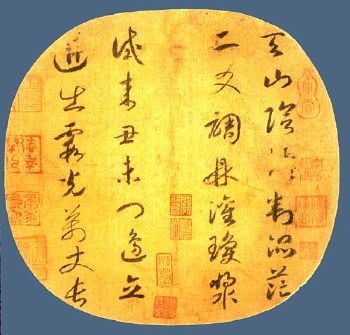
Some forms of poetry are specific to particular cultures and genres, responding to the characteristics of the language in which the poet writes. While readers accustomed to identifying poetry with Dante, Goethe, Mickiewicz, and Rumi may think of it as being written in rhyming lines and regular meter, there are traditions, such as those of Du Fu and Beowulf, that use other approaches to achieve rhythm and euphony. In today's globalized world, poets often borrow styles, techniques, and forms from diverse cultures and languages.
History
Poetry as an art form may predate literacy.[4] Many ancient works, from the Vedas (1700–1200 B.C.E.) to the Odyssey (eighth century B.C.E.–675 B.C.E.), appear to have been composed in poetic form to aid memorization and oral transmission, in prehistoric and ancient societies.[5] Others suggest that poetry did not necessarily predate writing.[6] Poetry appears among the earliest records of most literate cultures, with poetic fragments found on early monoliths, rune stones and stelae.
The oldest surviving poem is the Epic of Gilgamesh, from the third millennium B.C.E. in Sumer (in Mesopotamia, now Iraq), which was written in cuneiform script on clay tablets and, later, papyrus.[7] Other ancient epic poetry includes the Greek epics, Iliad and Odyssey, and the Indian epics, Ramayana and Mahabharata.
The efforts of ancient thinkers to determine what makes poetry distinctive as a form, and what distinguishes good poetry from bad, resulted in "poetics"–the study of the aesthetics of poetry. Some ancient societies, such as the Chinese through the Shi Jing, one of the Five Classics of Confucianism, developed canons of poetic works that had ritual as well as aesthetic importance. More recently, thinkers have struggled to find a definition that could encompass formal differences as great as those between Chaucer's Canterbury Tales and Matsuo Bashō's Oku no Hosomichi, as well as differences in context spanning Tanakh religious poetry, love poetry, and rap.
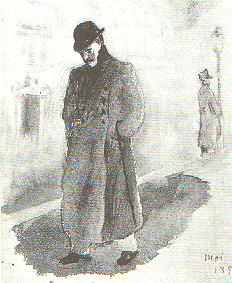
Context can be critical to poetics and to the development of poetic genres and forms. Poetry that records historic events in epics, such as Gilgamesh or Ferdowsi's Shahnameh,[8] will necessarily be lengthy and narrative, while poetry used for liturgical purposes (hymns, psalms, suras and hadiths) is likely to have an inspirational tone, whereas elegy and tragedy are meant to evoke deep emotional responses. Other contexts include Gregorian chants, formal or diplomatic speech, for example, in the Arabic world, much diplomacy was carried out through poetic form in the sixteeenth century. [9] political rhetoric and invective,[10] light-hearted nursery and nonsense rhymes, and even medical texts.[11]
The Polish historian of aesthetics, Władysław Tatarkiewicz, in a paper on "The Concept of Poetry," traces the evolution of what is in fact two concepts of poetry. Tatarkiewicz points out that the term is applied to two distinct things that, as the poet Paul Valéry observes, "at a certain point find union. Poetry […] is an art based on language. But poetry also has a more general meaning […] that is difficult to define because it is less determinate: poetry expresses a certain state of mind."[12]
Western traditions
Classical thinkers employed classification as a way to define and assess the quality of poetry. Notably, the existing fragments of Aristotle's Poetics describe three genres of poetry—the epic, the comic, and the tragic—and develop rules to distinguish the highest-quality poetry in each genre, based on the underlying purposes of the genre.[1] Later aestheticians identified three major genres: epic poetry, lyric poetry and dramatic poetry, treating comedy and tragedy as subgenres of dramatic poetry.
Aristotle's work was influential throughout the Middle East during the Islamic Golden Age,[13] as well as in Europe during the Renaissance.[14] Later poets and aestheticians often distinguished poetry from, and defined it in opposition to, prose, which was generally understood as writing with a proclivity to logical explication and a linear narrative structure. Kant, for example, argues that the nature of poetry as a self-consciously abstract and beautiful form raises it to the highest level among the verbal arts, with tone or music following it, and only after that the more logical and narrative prose.[2]
This does not imply that poetry is illogical or lacks narration, but rather that poetry is an attempt to render the beautiful or sublime without the burden of engaging the logical or narrative thought process. English Romantic poet John Keats termed this escape from logic, "Negative Capability."[15] This "romantic" approach views form as a key element of successful poetry because form is abstract and distinct from the underlying notional logic. This approach remained influential into the twentieth century.
During this period, there was also substantially more interaction among the various poetic traditions, in part due to the spread of European colonialism and the attendant rise in global trade. In addition to a boom in translation, during the Romantic period numerous ancient works were rediscovered.
Twentieth-century disputes
Some twentieth century literary theorists, relying less on the opposition of prose and poetry, focused on the poet as simply one who creates using language, and poetry as what the poet creates. The underlying concept of the poet as creator is not uncommon, and some modernist poets essentially do not distinguish between the creation of a poem with words, and creative acts in other media such as carpentry.[3] Yet other modernists challenge the very attempt to define poetry as misguided, as when Archibald MacLeish concludes his paradoxical poem, "Ars Poetica," with the lines: "A poem should not mean / but be."[16]
Disputes over the definition of poetry, and over poetry's distinction from other genres of literature, have been inextricably intertwined with the debate over the role of poetic form. The rejection of traditional forms and structures for poetry that began in the first half of the twentieth century, coincided with a questioning of the purpose and meaning of traditional definitions of poetry and of distinctions between poetry and prose, particularly given examples of poetic prose and prosaic "poetry". Numerous modernist poets have written in non-traditional forms or in what traditionally would have been considered prose, although their writing was generally infused with poetic diction and often with rhythm and tone established by non-metrical means.[17] While there was a substantial formalist reaction within the modernist schools to the breakdown of structure, this reaction focused as much on the development of new formal structures and syntheses as on the revival of older forms and structures.[18]
More recently, postmodernism has fully embraced MacLeish's concept and come to regard boundaries between prose and poetry, and also among genres of poetry, as having meaning only as cultural artifacts. Postmodernism goes beyond modernism's emphasis on the creative role of the poet, to emphasize the role of the reader of a text, and to highlight the complex cultural web within which a poem is read.[19] Today, throughout the world, poetry often incorporates poetic form and diction from other cultures and from the past, further confounding attempts at definition and classification that were once sensible within a tradition such as the Western canon.
Basic elements
Prosody
Prosody is the study of the meter, rhythm, and intonation of a poem. Rhythm and meter, although closely related, should be distinguished.[20] Meter is the definitive pattern established for a verse (such as iambic pentameter), while rhythm is the actual sound that results from a line of poetry. Thus, the meter of a line may be described as being "iambic," but a full description of the rhythm would require noting where the language causes one to pause or accelerate and how the meter interacts with other elements of the language. Prosody also may be used more specifically to refer to the scanning of poetic lines to show meter.
Rhythm
The methods for creating poetic rhythm vary across languages and between poetic traditions. Languages are often described as having timing set primarily by accents, syllables, or moras, depending on how rhythm is established, though a language can be influenced by multiple approaches.[21] Japanese is a mora-timed language. Syllable-timed languages include Latin, Catalan, French and Spanish. English, Russian and, generally, German are stress-timed languages. Varying intonation also affects how rhythm is perceived. Languages also can rely on either pitch, such as in Vedic or ancient Greek, or tone. Tonal languages include Chinese, Vietnamese, Lithuanian, and most subsaharan languages.[22]
Metrical rhythm generally involves precise arrangements of stresses or syllables into repeated patterns called feet within a line. In Modern English verse the pattern of stresses primarily differentiate feet, so rhythm based on meter in Modern English is most often founded on the pattern of stressed and unstressed syllables (alone or elided). In the classical languages, on the other hand, while the metrical units are similar, vowel length rather than stresses define the meter. Old English poetry used a metrical pattern involving varied numbers of syllables but a fixed number of strong stresses in each line.[23]
The chief device of ancient Hebrew Biblical poetry, including many of the psalms, was parallelism, a rhetorical structure in which successive lines reflected each other in grammatical structure, sound structure, notional content, or all three. Parallelism lent itself to antiphonal or call-and-response performance, which could also be reinforced by intonation. Thus, Biblical poetry relies much less on metrical feet to create rhythm, but instead creates rhythm based on much larger sound units of lines, phrases and sentences. Some classical poetry forms, such as Venpa of the Tamil language, had rigid grammars (to the point that they could be expressed as a context-free grammar) which ensured a rhythm.[24] In Chinese poetry, tones as well as stresses create rhythm. Classical Chinese poetics identifies four tones: the level tone, rising tone, falling tone, and entering tone. Note that other classifications may have as many as eight tones for Chinese and six for Vietnamese.
The formal patterns of meter used developed in Modern English verse to create rhythm no longer dominate contemporary English poetry. In the case of free verse, rhythm is often organized based on looser units of cadence than a regular meter. Robinson Jeffers, Marianne Moore, and William Carlos Williams are three notable poets who reject the idea that regular accentual meter is critical to English poetry.[25][26] Robinson Jeffers experimented with sprung rhythm as an alternative to accentual rhythm.[27]
Meter
In the Western poetic tradition, meters are customarily grouped according to a characteristic metrical foot and the number of feet per line. Thus, "iambic pentameter" is a meter comprising five feet per line, in which the predominant kind of foot is the "iamb." This metric system originated in ancient Greek poetry, and was used by poets such as Pindar and Sappho, and by the great tragedians of Athens. Similarly, "dactylic hexameter," comprises six feet per line, of which the dominant kind of foot is the "dactyl." Dactylic hexameter was the traditional meter of Greek epic poetry, the earliest extant examples of which are the works of Homer and Hesiod.
Meter is often scanned based on the arrangement of "poetic feet" into lines.[28] In English, each foot usually includes one syllable with a stress and one or two without a stress. In other languages, it may be a combination of the number of syllables and the length of the vowel that determines how the foot is parsed, where one syllable with a long vowel may be treated as the equivalent of two syllables with short vowels. For example, in ancient Greek poetry, meter is based solely on syllable duration rather than stress. In some languages, such as English, stressed syllables are typically pronounced with greater volume, greater length, and higher pitch, and are the basis for poetic meter. In ancient Greek, these attributes were independent of each other; long vowels and syllables including a vowel plus more than one consonant actually had longer duration, approximately double that of a short vowel, while pitch and stress (dictated by the accent) were not associated with duration and played no role in the meter. Thus, a dactylic hexameter line could be envisioned as a musical phrase with six measures, each of which contained either a half note followed by two quarter notes (i.e., a long syllable followed by two short syllables), or two half notes (i.e., two long syllables); thus, the substitution of two short syllables for one long syllable resulted in a measure of the same length. Such substitution in a stress language, such as English, would not result in the same rhythmic regularity.
In Anglo-Saxon meter, the unit on which lines are built is a half-line containing two stresses rather than a foot.[29] Scanning meter can often show the basic or fundamental pattern underlying a verse, but does not show the varying degrees of stress, as well as the differing pitches and lengths of syllables.[20]
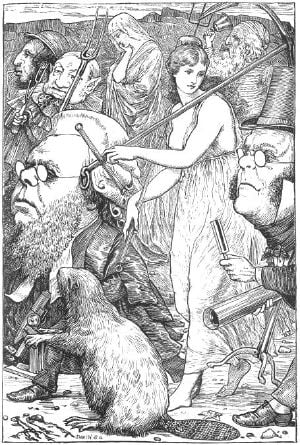
As an example of how a line of meter is defined, in English-language iambic pentameter, each line has five metrical feet, and each foot is an iamb, or an unstressed syllable followed by a stressed syllable. When a particular line is scanned, there may be variations upon the basic pattern of the meter; for example, the first foot of English iambic pentameters is quite often inverted, meaning that the stress falls on the first syllable.[20] The generally accepted names for some of the most commonly used kinds of feet include:
- spondee—two stressed syllables together
- iamb—unstressed syllable followed by a stressed syllable
- trochee—one stressed syllable followed by an unstressed syllable
- dactyl—one stressed syllable followed by two unstressed syllables
- anapest—two unstressed syllables followed by one stressed syllable
- pyrrhic - two unstressed syllables together (rare, usually used to end dactylic hexameter)
The number of metrical feet in a line are described in Greek terminology as follows:
- dimeter—two feet
- trimeter—three feet
- tetrameter—four feet
- pentameter—five feet
- hexameter—six feet
- heptameter—seven feet
- octameter—eight feet
There are a wide range of names for other types of feet, right up to a choriamb of four syllable metric foot with a stressed syllable followed by two unstressed syllables and closing with a stressed syllable. The choriamb is derived from some ancient Greek and Latin poetry. Languages which utilize vowel length or intonation rather than or in addition to syllabic accents in determining meter, such as Ottoman Turkish or Vedic, often have concepts similar to the iamb and dactyl to describe common combinations of long and short sounds.
Each of these types of feet has a certain "feel," whether alone or in combination with other feet. The iamb, for example, is the most natural form of rhythm in the English language, and generally produces a subtle but stable verse.[30] The dactyl, on the other hand, almost gallops along. And, as readers of The Night Before Christmas or Dr. Seuss realize, the anapest is perfect for a light-hearted, comic feel. For example, lines from "Yertle the Turtle" are scanned in anapestic tetrameter.[31]
There is debate over how useful a multiplicity of different "feet" is in describing meter. For example, Robert Pinsky has argued that while dactyls are important in classical verse, English dactylic verse uses dactyls very irregularly and can be better described based on patterns of iambs and anapests, feet which he considers natural to the language.[20] Actual rhythm is significantly more complex than the basic scanned meter described above, and many scholars have sought to develop systems that would scan such complexity. Vladimir Nabokov noted that overlaid on top of the regular pattern of stressed and unstressed syllables in a line of verse was a separate pattern of accents resulting from the natural pitch of the spoken words, and suggested that the term "scud" be used to distinguish an unaccented stress from an accented stress.[32]
Metrical patterns
Different traditions and genres of poetry tend to use different meters, ranging from the Shakespearean iambic pentameter and the Homerian dactylic hexameter to the Anapestic tetrameter used in many nursery rhymes. However, a number of variations to the established meter are common, both to provide emphasis or attention to a given foot or line and to avoid boring repetition. For example, the stress in a foot may be inverted, a caesura (or pause) may be added (sometimes in place of a foot or stress), or the final foot in a line may be given a feminine ending to soften it or be replaced by a spondee to emphasize it and create a hard stop. Some patterns (such as iambic pentameter) tend to be fairly regular, while other patterns, such as dactylic hexameter, tend to be highly irregular. Regularity can vary between language. In addition, different patterns often develop distinctively in different languages, so that, for example, iambic tetrameter in Russian will generally reflect a regularity in the use of accents to reinforce the meter, which does not occur or occurs to a much lesser extent in English.[32]
Some common metrical patterns, with notable examples of poets and poems who use them, include:
- Iambic pentameter (John Milton, Paradise Lost
- Dactylic hexameter (Homer, Iliad; Ovid, The Metamorphoses)
- Iambic tetrameter (Andrew Marvell, "To His Coy Mistress")
- Iambic tetrameter (Aleksandr Pushkin, Eugene Onegin)
- Trochaic octameter (Edgar Allan Poe, "The Raven")
- Anapestic tetrameter (Lewis Carroll, "The Hunting of the Snark" Lord Byron, Don Juan)
- Alexandrine, also known as iambic hexameter (Jean Racine, Phèdre)
Rhyme, alliteration, assonance
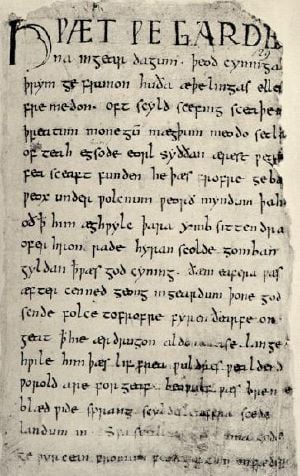
Rhyme, alliteration, assonance and consonance are ways of creating repetitive patterns of sound. They may be used as an independent structural element in a poem, to reinforce rhythmic patterns, or as an ornamental element.[33]
Rhyme consists of identical ("hard-rhyme") or similar ("soft-rhyme") sounds placed at the ends of lines or at predictable locations within lines ("internal rhyme").[34] Languages vary in the richness of their rhyming structures; Italian, for example, has a rich rhyming structure permitting maintenance of a limited set of rhymes throughout a lengthy poem. The richness results from word endings that follow regular forms. English, with its irregular word endings adopted from other languages, is less rich in rhyme.[34] The degree of richness of a language's rhyming structures plays a substantial role in determining what poetic forms are commonly used in that language.
Alliteration and assonance played a key role in structuring early Germanic, Norse and Old English forms of poetry. The alliterative patterns of early Germanic poetry interweave meter and alliteration as a key part of their structure, so that the metrical pattern determines when the listener expects instances of alliteration to occur. This can be compared to an ornamental use of alliteration in most Modern European poetry, where alliterative patterns are not formal or carried through full stanzas.[35] Alliteration is particularly useful in languages with less rich rhyming structures. Assonance, where the use of similar vowel sounds within a word rather than similar sounds at the beginning or end of a word, was widely used in skaldic poetry, but goes back to the Homeric epic. Because verbs carry much of the pitch in the English language, assonance can loosely evoke the tonal elements of Chinese poetry and so is useful in translating Chinese poetry. Consonance occurs where a consonant sound is repeated throughout a sentence without putting the sound only at the front of a word. Consonance provokes a more subtle effect than alliteration and so is less useful as a structural element.
Rhyming schemes
In many languages, including modern European languages and Arabic, poets use rhyme in set patterns as a structural element for specific poet forms, such as ballads, sonnets and rhyming couplets. However, the use of structural rhyme is not universal even within the European tradition. Much modern poetry avoids traditional rhyme schemes. Classical Greek and Latin poetry did not use rhyme. Rhyme entered European poetry in the High Middle Ages, in part under the influence of the Arabic language in Al Andalus (modern Spain).[36] Arabic language poets used rhyme extensively from the first development of literary Arabic in the sixth century, as in their long, rhyming qasidas. Some rhyming schemes have become associated with a specific language, culture or period, while other rhyming schemes have achieved use across languages, cultures or time periods. Some forms of poetry carry a consistent and well-defined rhyming scheme, such as the chant royal or the rubaiyat, while other poetic forms have variable rhyme schemes.
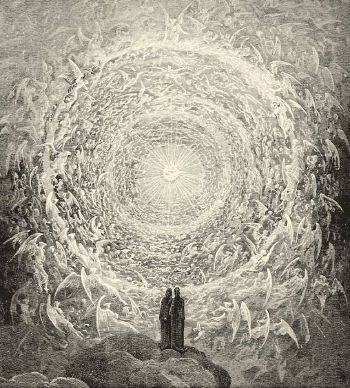
Most rhyme schemes are described using letters that correspond to sets of rhymes, so if the first, second and fourth lines of a quatrain rhyme with each other and the third line does not rhyme, the quatrain is said to have an "a-a-b-a" rhyme scheme. This rhyme scheme is the one used, for example, in the rubaiyat form.[37] Similarly, an "a-b-b-a" quatrain (what is known as "enclosed rhyme") is used in such forms as the Petrarchan sonnet. Some types of more complicated rhyming schemes have developed names of their own, separate from the "a-b-c" convention, such as the ottava rima and terza rima. The types and use of differing rhyming schemes is discussed further in the main article.
- Ottava rima
- The ottava rima is a poem with a stanza of eight lines with an alternating a-b rhyming scheme for the first six lines followed by a closing couplet first used by Boccaccio. This rhyming scheme was developed for heroic epics but has also been used for mock-heroic poetry.
- Dante and terza rima
Dante's Divine Comedy is written in terza rima, where each stanza has three lines, with the first and third rhyming, and the second line rhyming with the first and third lines of the next stanza (thus, a-b-a / b-c-b / c-d-c, et cetera.) in a chain rhyme. The terza rima provides a flowing, progressive sense to the poem, and used skillfully it can evoke a sense of motion, both forward and backward. Terza rima is appropriately used in lengthy poems in languages with rich rhyming schemes (such as Italian, with its many common word endings).[34]
Poetic form
Poetic form is very much more flexible nowadays than ever before. Many modern poets eschew recognizable structures or forms, and write in 'free verse'. But poetry remains distinguished from prose by its form and some regard for basic formal structures of poetry will be found in even the best free verse, howevermuch it may appear to have been ignored. Similarly, in the best poetry written in the classical style there will be departures from strict form for emphasis or effect. Among the major structural elements often used in poetry are the line, the stanza or verse paragraph, and larger combinations of stanzas or lines such as cantos. The broader visual presentation of words and calligraphy can also be utilized. These basic units of poetic form are often combined into larger structures, called poetic forms or poetic modes (see following section), such as in the sonnet or haiku.
Lines and stanzas
Poetry is often separated into lines on a page. These lines may be based on the number of metrical feet, or may emphasize a rhyming pattern at the ends of lines. Lines may serve other functions, particularly where the poem is not written in a formal metrical pattern. Lines can separate, compare or contrast thoughts expressed in different units, or can highlight a change in tone.
Lines of poems are often organized into stanzas, which are denominated by the number of lines included. Thus a collection of two lines is a couplet (or distich), three lines a triplet (or tercet), four lines a quatrain, five lines a quintain (or cinquain), six lines a sestet, and eight lines an octet. These lines may or may not relate to each other by rhyme or rhythm. For example, a couplet may be two lines with identical meters which rhyme or two lines held together by a common meter alone. Stanzas often have related couplets or triplets within them.
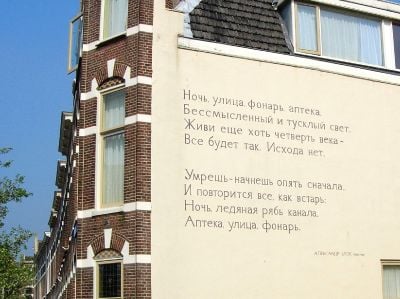
Other poems may be organized into verse paragraphs, in which regular rhymes with established rhythms are not used, but the poetic tone is instead established by a collection of rhythms, alliterations, and rhymes established in paragraph form. Many medieval poems were written in verse paragraphs, even where regular rhymes and rhythms were used.
In many forms of poetry, stanzas are interlocking, so that the rhyming scheme or other structural elements of one stanza determine those of succeeding stanzas. Examples of such interlocking stanzas include, for example, the ghazal and the villanelle, where a refrain (or, in the case of the villanelle, refrains) is established in the first stanza which then repeats in subsequent stanzas. Related to the use of interlocking stanzas is their use to separate thematic parts of a poem. For example, the strophe, antistrophe and epode of the ode form are often separated into one or more stanzas. In such cases, or where structures are meant to be highly formal, a stanza will usually form a complete thought, consisting of full sentences and cohesive thoughts.
In some cases, particularly lengthier formal poetry such as some forms of epic poetry, stanzas themselves are constructed according to strict rules and then combined. In skaldic poetry, the dróttkvætt stanza had eight lines, each having three "lifts" produced with alliteration or assonance. In addition to two or three alliterations, the odd numbered lines had partial rhyme of consonants with dissimilar vowels, not necessarily at the beginning of the word; the even lines contained internal rhyme in set syllables (not necessarily at the end of the word). Each half-line had exactly six syllables, and each line ended in a trochee. The arrangement of dróttkvætts followed far less rigid rules than the construction of the individual dróttkvætts.
Visual presentation
Even before the advent of printing, the visual appearance of poetry often added meaning or depth. Acrostic poems conveyed meanings in the initial letters of lines or in letters at other specific places in a poem. In Arabic, Hebrew and Chinese poetry, the visual presentation of finely calligraphed poems has played an important part in the overall effect of many poems.
With the advent of printing, poets gained greater control over the mass-produced visual presentations of their work. Visual elements have become an important part of the poet's toolbox, and many poets have sought to use visual presentation for a wide range of purposes. Some Modernist poetry takes this to an extreme, with the placement of individual lines or groups of lines on the page forming an integral part of the poem's composition, whether to complement the poem's rhythm through visual caesuras of various lengths, or to create juxtapositions so as to accentuate meaning, ambiguity or irony, or simply to create an aesthetically pleasing form.[38] In its most extreme form, this can lead to concrete poetry or asemic writing.[39]
Poetic diction
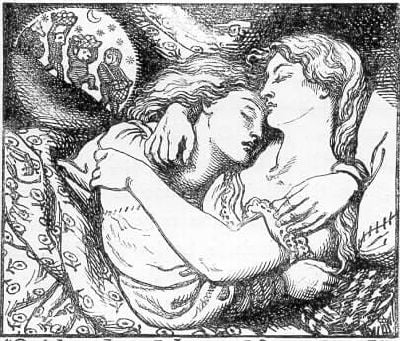
Poetic diction describes the manner in which language is used and refers not only to the sound but also to the underlying meaning and its interaction with sound and form. Many languages and poetic forms have very specific poetic dictions, to the point where separate grammars and dialects are used specifically for poetry. Poetic diction can include rhetorical devices such as simile and metaphor, as well as tones of voice, such as irony.[40] Aristotle wrote in the Poetics that "the greatest thing by far is to be a master of metaphor." Since the rise of Modernism, some poets have opted for a poetic diction that de-emphasizes rhetorical devices, attempting the direct presentation of things and experiences and the exploration of tone. On the other hand, Surrealists have pushed rhetorical devices to their limits, making frequent use of catachresis.
Allegorical stories are central to the poetic diction of many cultures, and were prominent in the west during classical times, the late Middle Ages and Renaisance.[41] A poem may contain symbols or allusion that deepens the meaning or impact of its words without constructing a full allegory. Another strong element of poetic diction can be the use of vivid imagery for effect. The juxtaposition of unexpected or impossible images is, for example, a particularly strong element in surrealist poetry and haiku. Vivid images are often endowed with symbolism as well.
Many poetic dictions will use repetitive phrases for effect, either a short phrase (such as Homer's "rosy-fingered dawn") or a longer refrain. Such repetition can add a somber tone to a poem, as in many odes, or can be laced with irony as the contexts of the words change. For example, in Antony's famous eulogy to in Shakespeare's Julius Caesar, Anthony's repetition of the words, "for Brutus is an honorable man," moves from a sincere tone to one that exudes irony.[42]
Poetic forms
Specific poetic forms have been developed by many cultures. In more developed, closed or "received" poetic forms, the rhyming scheme, meter and other elements of a poem are based on sets of rules, ranging from the relatively loose rules that govern the construction of an elegy to the highly formalized structure of the ghazal or villanelle. Described below are some common forms of poetry widely used across a number of languages. Additional forms of poetry may be found in the discussions of poetry of particular cultures or periods and in the glossary.
- Sonnets
Among the most common form of poetry through the ages is the sonnet, which, by the thirteenth century, was a poem of 14 lines following a set rhyme scheme and logical structure. The conventions associated with the sonnet have changed during its history, and so there are several different sonnet forms. Traditionally, English poets use iambic pentameter when writing sonnets, with the Spenserian and Shakespearean sonnets being especially notable. In the Romance languages, the hendecasyllable and Alexandrines are the most widely used meters, although the Petrarchan sonnet has been used in Italy since the fourteenth century. Sonnets are particularly associated with love poetry, and often use a poetic diction heavily based on vivid imagery, but the twists and turns associated with the move from octave to sestet and to final couplet make them a useful and dynamic form for many subjects. Shakespeare's sonnets are among the most famous in English poetry, with 20 being included in the Oxford Book of English Verse.[43]
- Jintishi
The jintishi (近體詩) is a Chinese poetic form based on a series of set tonal patterns using the four tones of the classical Chinese language in each couplet: the level, rising, falling and entering tones. The basic form of the jintishi has eight lines in four couplets, with parallelism between the lines in the second and third couplets. The couplets with parallel lines contain contrasting content but an identical grammatical relationship between words. Jintishi often have a rich poetic diction, full of allusion, and can have a wide range of subject, including history and politics. One of the masters of the form was Du Fu, who wrote during the Tang Dynasty (eighth century). There are several variations on the basic form of the jintishi.
- Sestina
The sestina has six stanzas, each comprising six unrhymed lines, in which the words at the end of the first stanza’s lines reappear in a rolling pattern in the other stanzas. The poem then ends with a three-line stanza in which the words again appear, two on each line.
- Villanelle
The Villanelle is a 19-line poem made up of five triplets with a closing quatrain; the poem is characterized by having two refrains, initially used in the first and third lines of the first stanza, and then alternately used at the close of each subsequent stanza until the final quatrain, which is concluded by the two refrains. The remaining lines of the poem have an a-b alternating rhyme. The villanelle has been used regularly in the English language since the late nineteenth century by such poets as Dylan Thomas,[44] W.H. Auden,[45] and Elizabeth Bishop.[46] It is a form that has gained increased use at a time when the use of received forms of poetry has generally been declining.
- Pantoum
The pantoum is a rare form of poetry similar to a villanelle. It is composed of a series of quatrains; the second and fourth lines of each stanza are repeated as the first and third lines of the next.
- Tanka
The Tanka is a form of Japanese poetry, generally not possessing rhyme, with five lines structured in a 5-7-5 7-7 patterns. The 5-7-5 phrase (the "upper phrase") and the 7-7 phrase (the "lower phrase") generally show a shift in tone and subject matter. Tanka were written as early as the Nara period by such poets as Kakinomoto no Hitomaro, at a time when Japan was emerging from a period where much of its poetry followed Chinese form. Tanka was originally the shorter form of Japanese formal poetry, and was used more heavily to explore personal rather than public themes. It thus had a more informal poetic diction. By the thirteenth century, Tanka had become the dominant form of Japanese poetry, and it is still widely written today.
- Ode
Odes were first developed by poets writing in ancient Greek, such as Pindar, and Latin, such as Horace, and forms of odes appear in many of the cultures influenced by the Greeks and Latins.[47] The ode generally has three parts: a strophe, an antistrophe, and an epode. The antistrophes of the ode possess similar metrical structures and, depending on the tradition, similar rhyme structures. In contrast, the epode is written with a different scheme and structure. Odes have a formal poetic diction, and generally deal with a serious subject. The strophe and antistrophe look at the subject from different, often conflicting, perspectives, with the epode moving to a higher level to either view or resolve the underlying issues. Odes are often intended to be recited or sung by two choruses (or individuals), with the first reciting the strophe, the second the antistrophe, and both together the epode. Over time, differing forms for odes have developed with considerable variations in form and structure, but generally showing the original influence of the Pindaric or Horatian ode. One non-Western form which resembles the ode is the qasida in Persian poetry.
- Ghazal
The ghazal (Persian/Urdu/Arabic: غزل) is a form of poetry common in Arabic, Persian, Urdu and Bengali poetry. In classic form, the ghazal has from five to fifteen rhyming couplets that share a refrain at the end of the second line (which need be of only a few syllables). Each line has an identical meter, and there is a set pattern of rhymes in the first couplet and among the refrains. Each couplet forms a complete thought and stands alone, and the overall ghazal often reflects on a theme of unattainable love or divinity. The last couplet generally includes the signature of the author.
As with other forms with a long history in many languages, many variations have been developed, including forms with a quasi-musical poetic diction in Urdu. Ghazals have a classical affinity with Sufism, and a number of major Sufi religious works are written in ghazal form. The relatively steady meter and the use of the refrain produce an incantatory effect, which complements Sufi mystical themes well. Among the masters of the form is Rumi, a Persian poet who lived in Turkey.
- Acrostic
A poem in which the first letters of the lines, when read downward, form a word, phrase, or sentence.
- Cinquain
A poem that has five lines with two, four, six, eight, and two syllables, respectively.
- Concrete
A poem that uses typeface, word arrangement, spacing, special characters, and color to dramatize the words’ meaning by the way they look.
- Free verse
Poetry that is based on the irregular rhythmic cadence or the recurrence, with variations, of phrases, images, and syntactical patterns rather than the conventional use of meter.
Poetic genres
In addition to specific forms of poems, poetry is often thought of in terms of different genres and subgenres. A poetic genre is generally a tradition or classification of poetry based on the subject matter, style, or other broader literary characteristics.[48] Some commentators view genres as natural forms of literature.[49] Others view the study of genres as the study of how different works relate and refer to other works.[50]
Epic poetry is one commonly identified genre, often defined as lengthy poems focused on an action-based narrative. Lyric poetry, which tends to be shorter, melodic, and contemplative, is another commonly identified genre. Some commentators may organize bodies of poetry into further subgenres, and individual poems may be seen as a part of many different genres.[51] In many cases, poetic genres show common features as a result of a common tradition, even across cultures. Thus, Greek lyric poetry influenced the genre's development from India to Europe.
Described below are some common genres, but the classification of genres, the description of their characteristics, and even the reasons for undertaking a classification into genres can take many forms.
- Narrative poetry
Narrative poetry is a genre of poetry that tells a story. Broadly it subsumes epic poetry, but the term "narrative poetry" is often reserved for smaller works, generally with more direct appeal than the epic to human interest.
Narrative poetry may be the oldest genre of poetry. Many scholars of Homer have concluded that his Iliad and Odyssey were composed from compilations of shorter narrative poems that related individual episodes and were more suitable for an evening's entertainment. Much narrative poetry—such as Scots and English ballads, and Baltic and Slavic heroic poems—is performance poetry with roots in a preliterate oral tradition. It has been speculated that some features that distinguish poetry from prose, such as meter, alliteration and kennings, once served as memory aids for bards who recited traditional tales.
Notable narrative poets have included Ovid, Dante, Chaucer, William Langland, Luís de Camões, William Shakespeare, Alexander Pope, Robert Burns, Adam Mickiewicz, Alexander Pushkin, Edgar Allan Poe and Alfred Lord Tennyson.
- Epic poetry
Epic poetry is a genre of poetry, and a major form of narrative literature. It recounts, in a continuous narrative, the life and works of a heroic or mythological person or group of persons. Western epic poems include Homer's Iliad and Odyssey, Vergil's Aeneid, the Nibelungenlied and Luís de Camões' Os Lusíadas. Eastern examples are the Epic of Gilgamesh, the Mahabharata, Valmiki's Ramayana, Ferdowsi's Shahnameh, and the Epic of King Gesar.
The composition of epic poetry, and of long poems generally, became uncommon in the west after the early twentieth century, while the meaning of the term "epic" evolved to refer also to prose writings, films and similar works that are characterized by great length, multiple settings, large numbers of characters, or long span of time involved.
- Dramatic poetry
Dramatic poetry is drama written in verse to be spoken or sung, and appears in varying and sometimes related forms in many cultures. Greek tragedy, written in verse, widely influenced the development of both Western and Sanskrit drama, while dramatic verse in East Asia developed out of Chinese Opera and includes the Noh form in Japan.
Practical reasons to write drama in verse include ease of memorization and musical accompaniment. In the latter half of the twentieth century, verse drama fell almost completely out of favor with English-language dramatists. Christopher Fry and T.S. Eliot may have been its last practitioners in that language.
The best-known practitioners of this genre include Aeschylus, Sophocles, Gil Vicente, Jan Kochanowski and Shakespeare.
- Satirical Poetry
Poetry can be a powerful vehicle for satire. The punch of an insult delivered in verse can be many times more powerful and memorable than the same when spoken or written in prose. The Greeks and Romans had a strong tradition of satirical poetry, often written for political purposes.
The same is true of the English satirical tradition. Embroiled in the feverish politics of the time and stung by an attack on him by his former friend, Thomas Shadwell (a Whig), John Dryden (a Tory), the first Poet Laureate, produced in 1682 Mac Flecknoe, one of the greatest pieces of sustained invective in the English language, subtitled "A Satire on the True Blue Protestant Poet, T.S." In this, the late, notably mediocre poet, Richard Flecknoe, was imagined to be contemplating who should succeed him as ruler "of all the realms of Nonsense absolute" to "reign and wage immortal war on wit."
Another exemplar of English satirical poetry was Alexander Pope, who chided critics in his Essay on Criticism (1709).
Dryden and Pope were writers of epic poetry, and their satirical style was accordingly epic; but there is no prescribed form for satirical poetry.
Outside England, Ignacy Krasicki and Manuel Maria Barbosa du Bocage, commonly known as Bocage, are among the greatest satirical poets.
- Lyric poetry
Lyric poetry is a genre that, unlike epic poetry and dramatic poetry, does not attempt to tell a story but instead is of a more personal nature. Rather than depicting characters and actions, it portrays the poet's own feelings, states of mind, and perceptions. While the genre's name, derived from "lyre," implies that it is intended to be sung, much lyric poetry is meant purely for reading.
Though lyric poetry has long celebrated love, many courtly-love poets also wrote lyric poems about war and peace, nature and nostalgia, grief and loss. Notable among these are the fifteenth century French lyric poets, Christine de Pizan and Charles, Duke of Orléans. Spiritual and religious themes were addressed by such medieval lyric poets as St. John of the Cross and Teresa of Ávila. The tradition of lyric poetry based on spiritual experience was continued by later poets such as John Donne, Gerard Manley Hopkins and T.S. Eliot.
Although the most popular form for western lyric poetry to take may be the 14-line sonnet, as practiced by Petrarch and Shakespeare, lyric poetry shows a bewildering variety of forms, including increasingly, in the twentieth century, unrhymed ones. This the most common type of poetry, as it deals intricately with the author's own emotions and views. Due to this fact, lyric poems of the First-person narrative are often accused of navel-gazing, and may be scorned by other, less self-centered, poets.
- Verse fable
The fable is an ancient and near-ubiquitous literary genre, often (though not invariably) set in verse form. It is a brief, succinct story that features anthropomorphized animals, plants, inanimate objects, or forces of nature that illustrate a moral lesson (a "moral"). Verse fables have used a variety of meter and rhyme patterns; Ignacy Krasicki, for example, in his Fables and Parables, used 13-syllable lines in rhyming couplets.
Notable verse fabulists have included Aesop (mid-6th century B.C.E.), Vishnu Sarma (ca. 200 B.C.E.), Phaedrus (15 B.C.E.–50 C.E.), Marie de France (12th century), Biernat of Lublin (1465?–after 1529), Jean de La Fontaine (1621–95), Ignacy Krasicki (1735–1801), Ivan Krylov (1769–1844) and Ambrose Bierce (1842–1914). All of Aesop's translators and successors have owed a fundamental debt to that semi-legendary fabulist.
- Prose poetry
Prose poetry is a hybrid genre that demonstrates attributes of both prose and poetry. It may be indistinguishable from the micro-story (aka the "short short story," "flash fiction"). Most critics argue that it qualifies as poetry because of its conciseness, use of metaphor, and special attention to language.
While some examples of earlier prose strike modern readers as poetic, prose poetry is commonly regarded as having originated in nineteenthth-century France, where its practitioners included Aloysius Bertrand, Charles Baudelaire, Arthur Rimbaud and Stéphane Mallarmé.
The genre has subsequently found notable exemplars in French (Francis Ponge); Portuguese (Fernando Pessoa, Mário Cesariny, Mário De Sá-Carneiro, Eugénio de Andrade, Al Berto, Alexandre O'Neill, José Saramago, António Lobo Antunes); English (Oscar Wilde, T.S. Eliot, Gertrude Stein, Sherwood Anderson, Allen Ginsberg, Seamus Heaney, Russell Edson, Charles Simic, Robert Bly, James Wright); Spanish (Octavio Paz, Ángel Crespo); Polish (Bolesław Prus); Russian; and Japanese.
Since the late 1980s especially, prose poetry has gained increasing popularity, with journals devoted solely to that genre.
Notes
- ↑ 1.0 1.1 Malcolm Heath (ed), Aristotle's Poetics (London: Penguin Books, 1997, ISBN 0140446362).
- ↑ 2.0 2.1 Immanuel Kant, J.H. Bernhard (trans.), Critique of Judgment (Wentworth Press, 2016, ISBN 978-1371253288).
- ↑ 3.0 3.1 Dylan Thomas, Quite Early One Morning (New York: New Direction Books, 1968, ISBN 0811202089).
- ↑ Many scholars, particularly those researching the Homeric tradition and the oral epics of the Balkans, suggest that early writing shows clear traces of older oral poetic traditions, including the use of repeated phrases as building blocks in larger poetic units. A rhythmic and repetitious form would make a long story easier to remember and retell, before writing was available as an aide-memoire.
- ↑ Frederick Ahl and Hannah M. Roisman, The Odyssey Re-Formed (Ithaca, NY: Cornell University Press, 1996, ISBN 0801483352), 1–26.
- ↑ Jack Goody, The Interface Between the Written and the Oral (Cambridge, UK: Cambridge University Press, 1987, ISBN 0521337941), 98.
- ↑ N.K. Sanders, (trans.), The Epic of Gilgamesh (Penguin Classics, 1960, ISBN 978-0140441000).
- ↑ Abolqasem Ferdowsi, Dick Davis (Trans.), Shahnameh: The Persian Book of Kings (New York: Viking, 2006, ISBN 0670034851).
- ↑ Natalie Zemon Davis, Trickster's Travels (Hill & Wang, 2006, ISBN 0809094355).
- ↑ Examples of political invective include libel poetry and the classical epigrams of Martial and Catullus.
- ↑ In ancient Greece, medical and scholarly works were often written in metrical form. A millennium and a half later, many of Avicenna's medical texts were written in verse.
- ↑ Władysław Tatarkiewicz, "The Concept of Poetry," Dialectics and Humanism II(2) (Spring 1975): 13.
- ↑ Ibn Rushd wrote a commentary on the Aristotle's Poetics, replacing the original examples with passages from Arabic poets. See, for example, W. F. Bogges, 'Hermannus Alemannus' Latin Anthology of Arabic Poetry,' Journal of the American Oriental Society 88 (1968): 657–670, and Charles Burnett, "Learned Knowledge of Arabic Poetry, Rhymed Prose, and Didactic Verse from Petrus Alfonsi to Petrarch," in Poetry and Philosophy in the Middle Ages: A Festschrift for Peter Dronke (Brill Academic Publishers, 2001, ISBN 9004119647).
- ↑ Paul F. Grendler, The Universities of the Italian Renaissance (Baltimore, MD: Johns Hopkins University Press, 2004, ISBN 0801880556).
- ↑ A. Christensen, L. Crisafulli-Jones, G. Galigani, and A. Johnson (eds.), The Challenge of Keats (Amsterdam, The Netherlands: Rodopi, 2000, ISBN 978-9042004993).
- ↑ The title of "Ars Poetica" alludes to Horace's commentary of the same title. The poem sets out a range of dicta for what poetry ought to be, before concluding with its classic lines.
- ↑ A. Walton Litz and Christopher MacGowan (eds.), The Collected Poems of William Carlos Williams (New York, NY: New Directions Publications, 1991, ISBN 978-0811211871).
- ↑ T. S. Eliot, The Waste Land and Other Poems (Vintage, 2021, ISBN 978-0593313343).
- ↑ Roland Barthes, "Death of the Author" in Image Music Text (Hill and Wang, 1978, ISBN 0374521360).
- ↑ 20.0 20.1 20.2 20.3 Robert Pinsky, The Sounds of Poetry (New York: Farrar, Straus and Giroux, 1998, ISBN 9780374266950).
- ↑ Julia Schülter, Rhythmic Grammar: The Influence of Rhythm on Grammatical Variation and Change in English (Berlin, Germany: Walter de Gruyter, 2005, ISBN 3110186071).
- ↑ Moria Yip, Tone (Cambridge: Cambridge University Press, 2002, ISBN 0521773148).
- ↑ Howell D. Chickering, Beowulf: a Dual-language Edition (Garden City, NY: Anchor, 1977, ISBN 0385062133).
- ↑ John Lazarus, W. H. Drew (trans.), Thirukkural (Asian Educational Services, 2001, ISBN 8120604008).
- ↑ Marianne Moore, Idiosyncrasy and Technique (Berkeley, CA: University of California, 1958).
- ↑ William Carlos Williams, The Broken Span (Norfolk, CT: New Directions, 1941).
- ↑ Robinson Jeffers, Selected Poems (New York, NY: Vintage, 1965, ISBN 978-0394702957).
- ↑ Paul Fussell, Poetic Meter and Poetic Form (McGraw-Hill, 1979, ISBN 978-0075536062).
- ↑ Christine Brooke-Rose, A ZBC of Ezra Pound (Faber and Faber, 1971, ISBN 0571091350).
- ↑ John Thompson, The Founding of English Meter (Columbia University Press, 1966).
- ↑ Dr. Seuss, Yertle the Turtle and Other Stories (New York: Random House, 1958, ISBN 978-0394800875).
- ↑ 32.0 32.1 Vladimir Nabokov, Notes on Prosody (New York: The Bollingen Foundation, 1964, ISBN 0691017603).
- ↑ Rhyme, alliteration, assonance or consonance can also carry a meaning separate from the repetitive sound patterns created. For example, Chaucer used heavy alliteration to mock Old English verse and to paint a character as archaic, and Christopher Marlowe used interlocking alliteration and consonance of "th," "f" and "s" sounds to force a lisp on a character he wanted to paint as effeminate. See, for example, the opening speech in Tamburlaine the Great Project Gutenberg. Retrieved March 4, 2023.
- ↑ 34.0 34.1 34.2 Dante Alighieri. Robert Pinsky (trans.), The Inferno of Dante: A New Verse Translation (New York: Farar Straus & Giroux, 1994, ISBN 0374176744).
- ↑ Burton Raffel, Sir Gawain and the Green Knight (New York: Signet Books, 1984, ISBN 0451628233).
- ↑ Maria Rosa Menocal, The Arabic Role in Medieval Literary History (Philadelphia: University of Pennsylvania, 2003, ISBN 0812213246). Irish poetry also employed rhyme relatively early, and may have influenced the development of rhyme in other European languages.
- ↑ Indeed, in translating the Rubaiyat of Omar Khayyam, Edward FitzGerald sought to retain the scheme in English.
- ↑ For examples of different uses of visual space in modern poetry, see E. E. Cummings works or C.J. Moore's poetic translation of the Fables of La Fontaine, which uses color and page placement to complement the illustrations of Marc Chagall. C.J. Moore (trans.), Marc Chagall: Fables of La Fontaine (The New Press, 1977, ISBN 1565844041).
- ↑ A good pre-modernist example of concrete poetry is the poem about the mouse's tale in the shape of a long tail in Lewis Carroll's Alice's Adventures in Wonderland.
- ↑ See, for example, The Rime of the Ancient Mariner by Samuel Taylor Coleridge for a well-known example of symbolism and metaphor used in poetry. The albatross that is killed by the mariner is a traditional symbol of good luck, and its death takes on metaphorical implications.
- ↑ Aesop's Fables, rendered in both verse and prose repeatedly since first being recorded about 500 B.C.E., are perhaps the richest single source of allegorical poetry through the ages. Other notables examples include the Roman de la Rose, a thirteenth-century French poem; William Langland's Piers Ploughman in the fourteenth century; and Jean de la Fontaine's Fables (influenced by Aesop's) in the seventeenth century.
- ↑ See Act III, Scene II in Shakespeare's The Tragedy of Julius Caesar.
- ↑ Arthur Quiller-Couch (ed.), Oxford Book of English Verse (Oxford University Press, 1939). Note that the relative prominence of a poet or a set of works is often measured by reference to the Oxford Book of English Verse or the Norton Anthology of Poetry, with many people counting poems or pages allocated to a given poet or subject.
- ↑ "Do Not Go Gentle into that Good Night" in Dylan Thomas, In Country Sleep and Other Poems (New York, NY: New Directions Publications, 1952).
- ↑ W.H. Auden, Collected Poems (New York, NY: Vintage, 1991, ISBN 0679731970).
- ↑ "One Art," in Elizabeth Bishop, Geography III (New York, NY: Farar, Straus & Giroux, 2008, ISBN 978-0374530655).
- ↑ In particular, the translations of Horace's odes by John Dryden were influential in establishing the form in English, though Dryden utilizes rhyme in his translations where Horace did not.
- ↑ Daniel Chandler, Introduction to Genre Theory, August 1977. Retrieved March 4, 2023.
- ↑ Northrup Frye, Anatomy of Criticism (Princeton, NJ: Princeton University Press, 2020, ISBN 978-0691202563).
- ↑ Jacques Derrida, Beverly Bie Brahic (trans.), Geneses, Genealogies, Genres, and Genius: The Secrets of the Archive (New York: Columbia University Press, 2006, ISBN 0231139780).
- ↑ Shakespeare parodied such analysis in Hamlet, describing the genres as consisting of "tragedy, comedy, history, pastoral, pastoral-comical, historical-pastoral, tragical-historical, tragical-comical-historical-pastoral…"
ReferencesISBN links support NWE through referral fees
- Ahl, Frederick, and Hannah M. Roisman. The Odyssey Re-Formed. Ithaca, NY: Cornell University Press, 1996. ISBN 0801483352
- Alighieri. Dante. Robert Pinsky (trans.). The Inferno of Dante: A New Verse Translation. New York: Farar Straus & Giroux, 1994. ISBN 0374176744
- Auden, W.H. Collected Poems. New York, NY: Vintage, 1991. ISBN 0679731970
- Barthes, Roland. Image Music Text. Hill and Wang, 1978. ISBN 0374521360
- Bishop, Elizabeth. Geography III. New York, NY: Farar, Straus & Giroux, 2008. ISBN 978-0374530655
- Brooke-Rose, Christine. A ZBC of Ezra Pound. Faber and Faber, 1971. ISBN 0571091350
- Burnett, Charles. "Learned Knowledge of Arabic Poetry, Rhymed Prose, and Didactic Verse from Petrus Alfonsi to Petrarch," in Poetry and Philosophy in the Middle Ages: A Festschrift for Peter Dronke. Brill Academic Publishers, 2001. ISBN 9004119647
- Chickering, Howell D. Beowulf: a Dual-language Edition. Garden City, NY: Anchor, 1977. ISBN 0385062133
- Christensen, A., L. Crisafulli-Jones, G. Galigani, and A. Johnson (eds.). The Challenge of Keats. Amsterdam, The Netherlands: Rodopi, 2000. ISBN 978-9042004993
- Davis, Natalie Zemon. Trickster's Travels. Hill & Wang, 2006. ISBN 0809094355
- Derrida, Jacques. Beverly Bie Brahic (trans.). Geneses, Genealogies, Genres, and Genius: The Secrets of the Archive. New York: Columbia University Press, 2006. ISBN 0231139780
- Eliot, T. S. The Waste Land and Other Poems. Vintage, 2021. ISBN 978-0593313343
- Ferdowsi, Abolqasem. Dick Davis (trans.). Shahnameh: The Persian Book of Kings. New York: Viking, 2006. ISBN 0670034851
- Frye, Northrup. Anatomy of Criticism. Princeton, NJ: Princeton University Press, 2020. ISBN 978-0691202563
- Fussell, Paul. Poetic Meter and Poetic Form. McGraw-Hill, 1979. ISBN 978-0075536062
- Goody, Jack. The Interface Between the Written and the Oral. Cambridge, UK: Cambridge University Press, 1987. ISBN 0521337941
- Grendler, Paul F. The Universities of the Italian Renaissance. Baltimore, MD: Johns Hopkins University Press, 2004. ISBN 0801880556
- Heath, Malcolm (ed.). Aristotle's Poetics. London: Penguin Books, 1997. ISBN 0140446362
- Jeffers, Robinson. Selected Poems. New York, NY: Vintage, 1965. ISBN 978-0394702957
- Kant, Immanuel. J.H. Bernhard (trans.). Critique of Judgment. Wentworth Press, 2016. ISBN 978-1371253288
- Lazarus, John. W. H. Drew (trans.). Thirukkural. Asian Educational Services, 2001. ISBN 8120604008
- Litz, A. Walton, and Christopher MacGowan (eds.). The Collected Poems of William Carlos Williams. New York, NY: New Directions Publications, 1991. ISBN 978-0811211871
- Menocal, Maria Rosa. The Arabic Role in Medieval Literary History. Philadelphia: University of Pennsylvania, 2003. ISBN 0812213246
- Moore, C.J. (trans.). Marc Chagall: Fables of La Fontaine. The New Press, 1977. ISBN 1565844041
- Moore, Marianne. Idiosyncrasy and Technique. Berkeley, CA: University of California, 1958.
- Nabokov, Vladimir. Notes on Prosody. New York: The Bollingen Foundation, 1964. ISBN 0691017603
- Pinsky, Robert. The Sounds of Poetry. New York: Farrar, Straus and Giroux, 1998. ISBN 9780374266950
- Quiller-Couch, Arthur (ed.). Oxford Book of English Verse. Oxford University Press, 1939. ASIN B000ANGERK
- Raffel, Burton. Sir Gawain and the Green Knight. New York: Signet Books, 1984. ISBN 0451628233
- Sanders, N.K. (trans.). The Epic of Gilgamesh. Penguin Classics, 1960. ISBN 978-0140441000
- Schülter, Julia. Rhythmic Grammar: The Influence of Rhythm on Grammatical Variation and Change in English. Berlin, Germany: Walter de Gruyter, 2005. ISBN 3110186071
- Seuss, Dr. Yertle the Turtle and Other Stories. New York: Random House, 1958. ISBN 978-0394800875
- Tatarkiewicz, Władysław. "The Concept of Poetry," translated by Christopher Kasparek, Dialectics and Humanism: the Polish Philosophical Quarterly II (2) (Spring 1975): 13–24. ISSN 0324-8275
- Thomas, Dylan. In Country Sleep and Other Poems. New York, NY: New Directions Publications, 1952.
- Thomas, Dylan. Quite Early One Morning. New York: New Direction Books, 1968. ISBN 0811202089
- Thompson, John. The Founding of English Meter. Columbia University Press, 1966. ASIN B000NTNDI4
- Williams, William Carlos. The Broken Span. Norfolk, CT: New Directions, 1941.
- Yip, Moria. Tone. Cambridge: Cambridge University Press, 2002. ISBN 0521773148
Anthologies
- Ferguson, Margaret, Mary Jo Salter, and Jon Stallworthy (eds.). The Norton Anthology of Poetry, 4th ed. New York: W.W. Norton & Co., 1996. ISBN 0393968200.
- Gardner, Helen (ed.). New Oxford Book of English Verse 1250-1950. New York and London, England: Oxford University Press, 1972. ISBN 0198121369
- Larkin, Philip (ed.). Oxford Book of Twentieth Century English Verse. New York and London: Oxford University Press, 1973. ISBN 9780198121374
- Laughlin, James, Peter Glassgold, and Griselda Jackson Ohannessian (eds.). New Directions 41: An International Anthology of Prose & Poetry. New Directions, 1980. ISBN 978-0811207706
- Yeats, W.B. (ed.). Oxford Book of Modern Verse 1892-1935. Oxford University Press, 1936. ISBN 978-0198121206
|
American poetry | Anglo-Welsh poetry | Arabic poetry | Australian Poetry | Bengali poetry | Bishnupriya Manipuri poetry | Biblical poetry | British poetry | Byzantine poetry | Canadian poetry | Chinese poetry | Classical Sanskrit poetry | Cornish poetry | English poetry | Finnish poetry | French poetry | Greek poetry | Guernésiais | Hindi poetry | Hebrew poetry | Indian poetry | Indian epic poetry | Irish poetry | Italian poetry | Japanese poetry | Javanese poetry | Jèrriais poetry | Kannada poetry | Kashmiri poetry | Korean poetry | Latin poetry Latin American poetry | Latino poetry | Manx poetry | Marathi poetry | Malayalam poetry | Nepali poetry | Old English poetry | Old Norse poetry | Ottoman poetry| Pakistani poetry | Pashto poetry | Persian poetry | Rajasthani poetry | Scottish poetry | Serbian epic poetry | Sindhi poetry | Slovak poetry | Spanish poetry | Tamil poetry | Telugu poetry | Turkish poetry | Urdu poetry | Vedic Sanksrit poetry | Welsh poetry |
|
Akhmatova's Orphans | The Beats | Black Arts Movement | Black Mountain poets | British Poetry Revival | Cairo poets | Cavalier poets | Chhayavaad | Churchyard poets | Confessionalists | Créolité | Cyclic Poets | Dadaism | Deep image | Della Cruscans | Dolce Stil Novo | Dymock poets | The poets of Elan | Flarf | Free Academy | Fugitives | Garip | Generation of '98 | Generation of '27 | Georgian poets | Goliard | The Group | Harlem Renaissance | Harvard Aesthetes | Imagism | Jindyworobak | Kimo | Lake Poets | Language poets | Martian poetry | Metaphysical poets | Misty Poets | Modernist poetry | The Movement | Négritude | New American Poetry | New Apocalyptics | New Formalism | New York School | Objectivists | Others group of artists | Parnassian poets | La Pléiade | Rhymers' Club | Rochester Poets | San Francisco Renaissance | Scottish Renaissance | Sicilian School | Sons of Ben | Southern Agrarians | Spasmodic poets | Sung poetry | Surrealism | Symbolism | Uranian poetry |
Credits
New World Encyclopedia writers and editors rewrote and completed the Wikipedia article in accordance with New World Encyclopedia standards. This article abides by terms of the Creative Commons CC-by-sa 3.0 License (CC-by-sa), which may be used and disseminated with proper attribution. Credit is due under the terms of this license that can reference both the New World Encyclopedia contributors and the selfless volunteer contributors of the Wikimedia Foundation. To cite this article click here for a list of acceptable citing formats.The history of earlier contributions by wikipedians is accessible to researchers here:
The history of this article since it was imported to New World Encyclopedia:
Note: Some restrictions may apply to use of individual images which are separately licensed.
